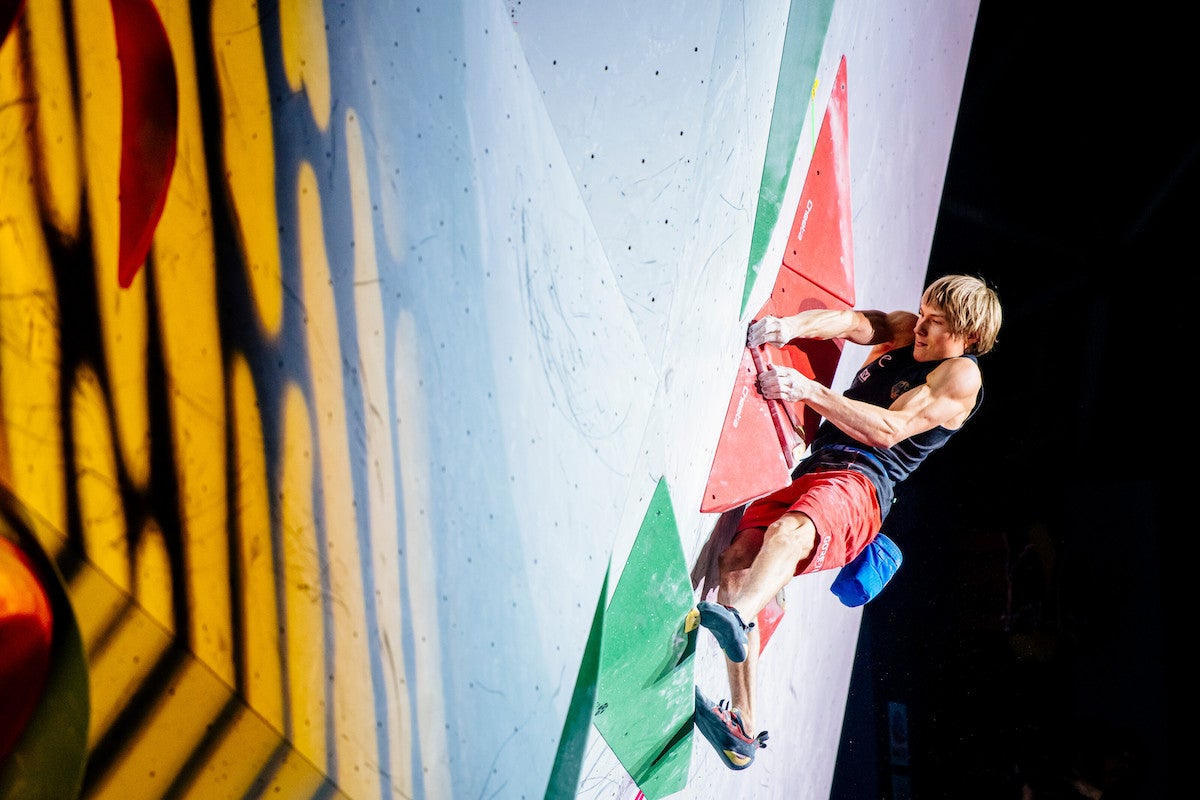
Pro climber Nina Williams shares 4 competition climbing tips.
The post How to Have Fun (And Climb Hard) at Comps appeared first on Climbing.
]]>
Think excelling at comps is as simple as just trying your hardest? Think again. Competing well requires strategizing—both with your scorecard and your mental game. For professional climber Nina Williams, the latter was especially important during her primary competition years, which ran from 2003 to 2015.
“How do you compare your own performance unless you’re measuring it against someone else?” she says of competition climbing. “How do you know where you stand?”
The key, she found, was competing often enough that she developed her own assessment of her skills, and could therefore draw on her past experiences to think about how to compete better in the future. As her career became more focused on outdoor ascents, especially her love of highballs like Bishop’s Ambrosia (V11), she also took the indoor competition scene less seriously, though she still competes here and there.
To her surprise, however, this new, less-serious approach improved her performance. Here, a few tips on how to have fun and perform well at comps, be they that local comp at your gym, a 24-hour climb-a-thon, or a national event.
1. Be prepared
Make sure you’re registered for the competition and have all the gear you need ahead of time, and don’t forget water and snacks. Having everything prepared early will help you relax leading up to and during the competition, so you’re not stressing about logistics. “I totally pick out my outfit the night before,” adds Williams.
2. Watch other people climb
Excited to hop on a cool-looking route? Wait, says Williams. Usually at competitions, you have to mark every fall you take, which can dock you points. Instead, watch other people climb to soak up beta. Whether or not the athletes climbing before you send, “you’ve got some idea of how to do the climb while also conserving your own energy,” says Williams.
3. Fill out your scorecard, even if the climbs are below your limit
A lot of competitors “get all psyched, as if it’s a regular gym session where they get caught up on one climb, and they just project it the whole time,” says Williams. In the end, they don’t even have the minimum number of climbs on their scorecard. (In most competitions, your score is the sum of points from your five or so hardest routes.)
Instead, says Williams, make it a priority to get those five climbs on your scorecard—even if they’re warm-ups or below your projecting level. “You’re already increasing your chances of placing well, because a lot of the time people won’t even get five climbs,” says Williams. Once you’ve completed this minimum, use the rest of your time to seek out more-challenging climbs.
4. Pay less attention to the other competitors, and more to the climbs that suit you
Williams says that in a recent competition, this year’s Portland Boulder Rally, she watched the other female competitors to see which climbs they were doing, and assess how many points they were racking up. But then as the comp progressed, she switched gears: “I turned inwards and started looking for climbs that I knew I could do regardless of what the other girls were doing.”
At the end, she happily turned in her scorecard knowing she’d done the best she could do. She then found she had made it to finals, and was able to place second after facing off with other crushers like Kyra Condie, Maya Madere, and Alex Johnson.
“Since adopting that mindset of I’m not going to take it as seriously, I actually have been having a lot more fun in comps, and as a result I’ve been doing better,” says Williams. “I’ve really had to learn over my entire climbing career to not compare myself to others and to only focus on my own performance.”
The post How to Have Fun (And Climb Hard) at Comps appeared first on Climbing.
]]>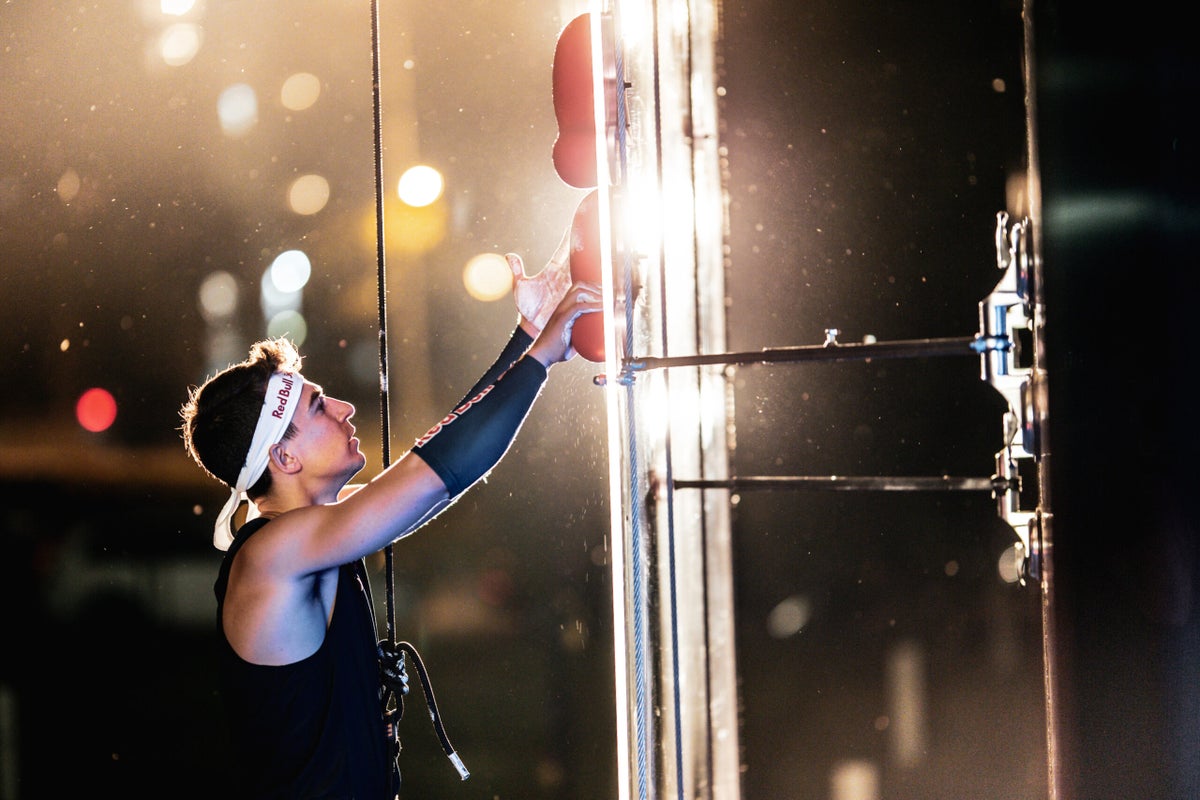
Everything you need to know about this faster version of climbing.
The post What the Hell is Speed Climbing? appeared first on Climbing.
]]>
You might have seen it in the Olympics or at your local gym: Those five-pointed red holds snaking back-and-forth up a slightly-overhanging wall, and the climbers racing up them. The timers, the records, the excitement. Welcome to … speed climbing.
But what in the hell is speed climbing, you ask?
It debuted within the Combined format of Sport Climbing at the 2020 Tokyo Olympics. In Paris 2024, it will be a stand-alone category.
The Format and Rules
The standards for speed climbing are determined by the International Federation of Sport Climbing (IFSC). The rules for an official IFSC speed climbing competition are simple: Climbers compete on the same route, side by side, and the first to the top wins. Times are recorded by a plate under the climber’s foot at the base of the route, and a light sensor at the top. The route is standardized. Every competitor can train on the same route at any gym that has a speed wall. Although the IFSC has to certify a wall if it’s to be used for an official competition or speed record, gyms can set an unofficial route by ordering the official holds and setting the course according to the IFSC’s specifications.
[Also Read: The Complete Guide to Olympic and World Cup Speed Climbing]
For a qualification round, athletes will get two attempts to climb the wall and log their fastest time. Then, based on those times, they are ranked first through 16th place. In the finals round, the climber in first place will race against the climber ranked in 16th place. Second place against 15th, third against 14th, and so on. The winners from each race move on to the next round, where the climber in first place races the one in eighth, second against seventh, and so on. Four more climbers are eliminated until you have races for the podium.

The wall itself is 15 meters, or about 50 feet, and sits at a 5-degree overhang. There are 20 handholds and 11 feet. There is no official grade for the speed route. While many speculative grades float around the Internet, it’s hard to nail down a specific number because speed climbing bears little resemblance to sport climbing. All the hands use one standardized hold (above), which includes a jug, punch, and slopers depending on where it’s grabbed. It’s safe to say that you can climb the route if you can climb 5.11. The challenge in speed climbing isn’t in climbing the route, it’s in climbing it fast.
Current records are held by Aleksandra Miroslaw, from Poland, and Veddriq Leonardo, from Indonesia, who set the times 6.84 and 5.20, respectively.
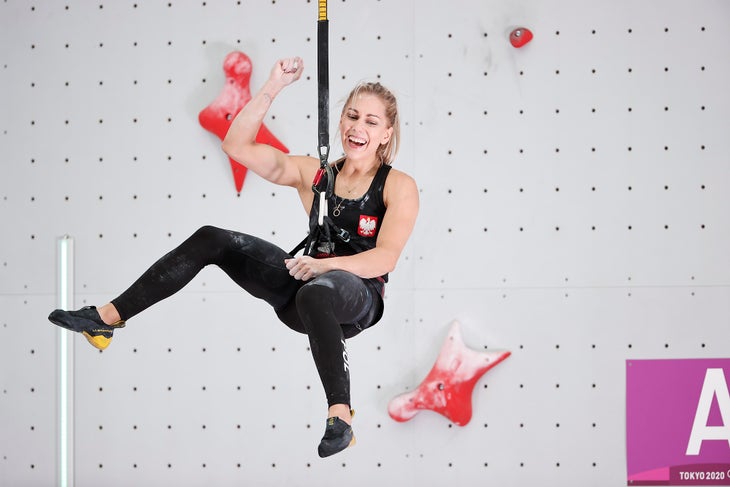
Athletes Weigh In
Sean McColl and John Brosler are two North American athletes that have a history of competing in Speed World Cups. Sean McColl, a Canadian competition climber, has been competing in speed climbing since his junior comp days, claiming gold medals in 2001 and 2006. Brosler, originally part of the Team Texas youth team, has been competing in speed climbing since 2009.
[Also Read: How Did Competitive Speed Climbing Become a Thing? Watch “Up To Speed”]
“I like how when you have an amazing run, you feel weightless and get the feeling of flying up the wall,” said McColl, a thought which Brosler echoed. “The feeling you get when you do better than you ever have before is amazing and addicting,” he said.
Speed climbing has been included in the World Cup Circuit for many years, but there have been fewer IFSC speed climbing competitions in the United States. Many U.S. gyms have speed walls, but only a small handful are approved for IFSC world records or competitions.
“Speed climbing is not as deeply rooted in North America as it is in some of the Eastern European countries,” said McColl, who is the former president and current vice president of the Athletes’ Commission for the IFSC. “I think as speed climbing continues to grow, we will see some world class athletes from North America.”
Brosler, who has won the U.S. National Championships six times, is one of those athletes. He sees his primary competition coming from abroad. “It’s actually really funny how much time I spend watching videos of Russians speed climb,” he said in an interview with Twin Dolphin Timing, one of the approved timer manufacturers for IFSC events.
Training
Training methods for speed climbing vary from climber to climber, but the level playing field of the discipline, as compared to lead and bouldering, offers an interesting look into different athletes’ routines.
Jan Kriz, a speed climber from the Czech Republic, has continued refining his method for the IFSC course since first competing in 2008.
“In my speed climbing career, I’ve changed my climbing technique several times. The last time was in 2015,” said Kriz. “I used to grab almost every single hold, because I wasn’t as strong as today. For now, I’m just working on frequency—doing all the moves as fast as possible and properly as well.”
Brosler also mentioned power and explosive movement exercises, but emphasized the mental aspects of his training.
“Because I know the route so well, most of my training occurs away from the speed wall and in the weight room. If you get stronger, you get faster, without many other variables involved,” he said. “However, mental training is by far the most beneficial aspect of my routine. Being able to replicate high-level performances from practice in competitions starts with having the same, positive mindset in both environments.”
[Also Read: Let’s Stop Bashing Speed Climbing And Accept That It’s Legitimate]
Additionally, training has to match the World Cup schedule, so athletes are at their peak for the championships, while still remaining strong enough and not over-trained during the preceding competitions.
McColl was preparing for the overall World Cup title in Paris when we spoke to him, which included sport, bouldering, and speed, like the Tokyo Olympic format.
“Paris is special because I’m not going there for only Speed,” he said. “In preparation, I trained a couple days on the official wall and have been doing cross training a few times a week over the past month.”
When all the training is done and hundredths of seconds are on the line, each athlete has their own method to prepare for competitions.
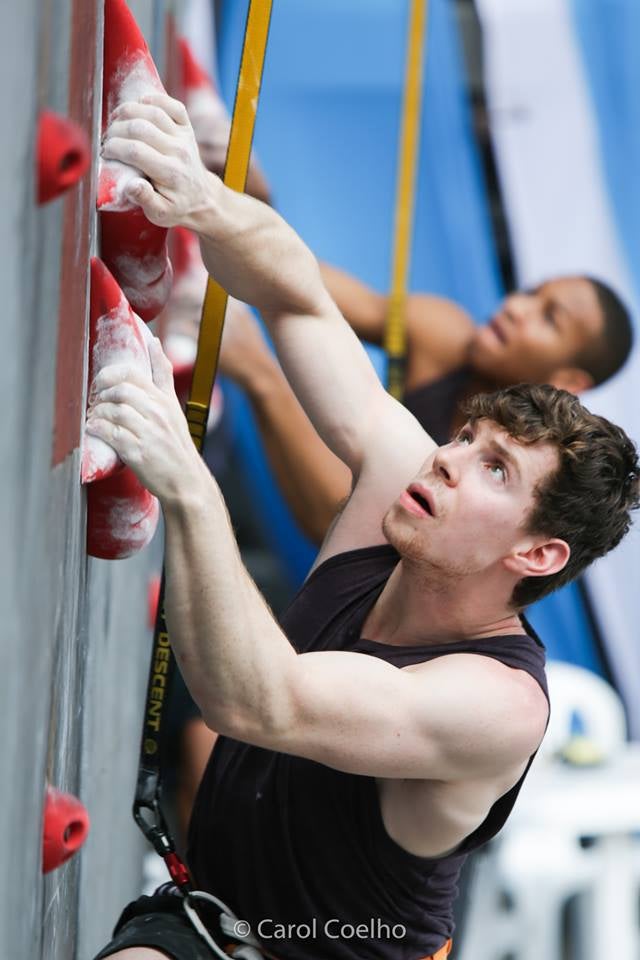
“In the isolation area at competitions, [I’m] psyching myself up with loud, exciting music and positive thoughts about my abilities. One of my favorite quotes, by Vertical World coach Tyson Schoene, runs through my head constantly before big competitions,” said Brosler. “Trust the training.”
For Kriz, the training isn’t over until the competition is a day away. “One day before an event I do easy exercises to activate my body and get the muscles in the right tension. Then I’m relaxing and keeping my mind clear and ready for the comps!” said Kriz.
Ultimately, McColl was eliminated during the speed qualifiers in Paris, landing in 38th place with a time of 8.65 seconds. John Brosler ended the comp in 12th place, finishing the course in 6.61 seconds during qualifiers and 7.21 seconds in the 1/8 finals round. Brosler scored highest among North American competitors.
The thrill of competing in speed climbing is obvious to participants, but those who will never enter a competition can have a hard time seeing the appeal. Competitions are dramatic and almost over too quickly, but Brosler and McColl have both seen benefits in their other climbing pursuits due to their speed climbing training.
“I think it has kept my legs strong for those jump-style boulders and also helped keep my lower body very athletic,” said McColl.
Brosler took it a step further, saying, “The entire basis of my sport climbing and bouldering fitness comes from the amount of effort I’ve put into improving my speed climbing.
The post What the Hell is Speed Climbing? appeared first on Climbing.
]]>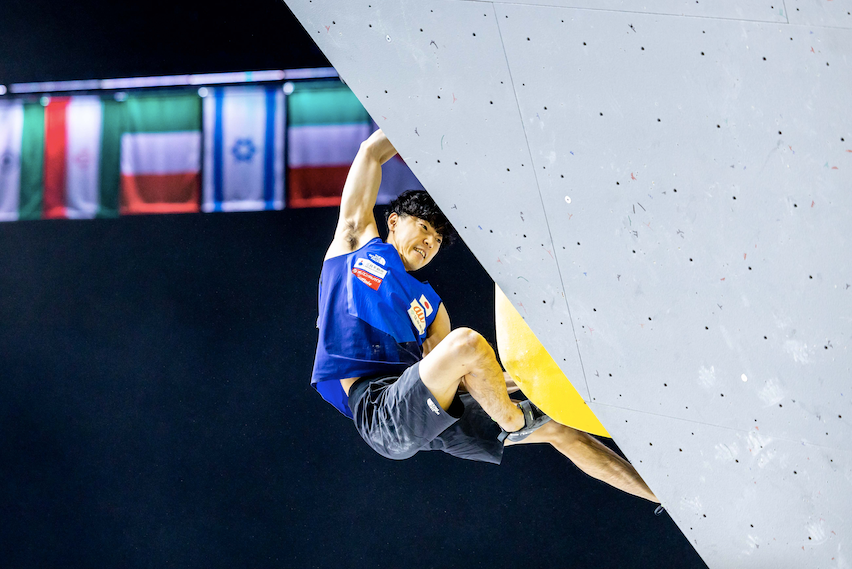
Just when you thought that 2021 could not get any better for Team USA, the World Championships kicked off this week in Russia and saw American athletes making the podium in the Speed and Boulder disciplines. At this point, you’ve probably lost count of Team USA’s total medal count for this current season (16, plus … Continued
The post Fujii Wins Bouldering Championships—But the Sexualization of Female Athletes Continues appeared first on Climbing.
]]>

Just when you thought that 2021 could not get any better for Team USA, the World Championships kicked off this week in Russia and saw American athletes making the podium in the Speed and Boulder disciplines.
At this point, you’ve probably lost count of Team USA’s total medal count for this current season (16, plus a silver medal at the Olympics by Nathaniel Coleman), but the important metric to remember here is that the last time an American medaled at the World Championships was in 2016, when Claire Buhrfeind earned a silver in the Combined. Other Americans have earned World Championships medals as well in the past (Alex Puccio Sasha DiGiulian, Emily Harrington, and Chris Sharma, among them), but you’d have to gaze way back at 1991 to find another year when multiple medals were won by Americans at the same World Championships (Robyn Erbesfield in Lead and Hans Florine in Speed back then).
Team USA’s remarkable performance this year was led by Noah Bratschi in the men’s Speed discipline. Bratschi rocketed through an early race in the finals to defeat Kazakhstan’s Amir Maimuratov. Bratschi then bested Russia’s Vladislav Deulin (who was competing under the CFR country designation) in the next round when Deulin’s left foot slipped and resulted in a costly fall. It was hardly a fluke victory for Bratschi, however, as he soon beat France’s Guillaume Moro as well to win the Small Final and claim the bronze medal. The race for gold was thrilling in its own right, with Ukraine’s Danyil Boldyrev clocking a blazing 5.733-seconds to win a neck-and-neck race against Spain’s Erik Noya Cardona. The win marked Boldyrev second World Championships gold medal, his other being in 2014.
The biggest star of the women’s Speed division was Poland’s Natalia Kalucka, who gritted through neck-and-neck heats in the finals to find herself racing against her Polish compatriot and world-record holder Aleksandra Miroslaw in the 1/2 final. A surprising slip by Miroslaw resulted in Kalucka cruising to an upset victory in the race; this was followed by another race in which Kalucka’s opponent—Iuliia Kaplina, competing under the CFR country designation—slipped, allowing Kalucka to claim victory and ultimately the gold medal. Kaplina finished with the silver, and Miroslaw earned the bronze.
In the Boulder discipline that followed, Team USA’s Natalia Grossman added to her dream season by giving possibly her best performance of the year. In fact, throughout all the women’s rounds, Grossman was never situated lower than first place, with an early highlight being her top of all four boulders in the semi-finals. However, Italy’s Camilla Moroni also topped the four boulders in that round and stayed close on Grossman’s heels. In the finals, it became apparent that Grossman and Moroni had begun a captivating rivalry on the wall: Moroni would top a boulder, only to have Grossman emerge from isolation moments later and equal the feat…or in some cases better it with a flash.
Fittingly, the scores came down to Moroni topping the last boulder in the finals on her second attempt, while Grossman managed to reach the top on a flash attempt to secure World Championship gold— the first Boulder gold medal for an American since Alex Puccio’s in 2014.
There were not any Americans in the men’s Boulder final, but that did not detract from the excitement. Like Grossman, Japan’s Kokoro Fujii topped every boulder in the final round, including the campusy first boulder that stumped all other competitors. Fujii was also one of the only competitors in the men’s division (the other being his compatriot, Tomoa Narasaki) to successfully traverse the slab of the third boulder. Fujii’s performance was so commanding throughout the final round that he secured the World Championship victory by reaching the zone on his second attempt on the last boulder. Sure, he eventually topped it, but that seemed like a formality; the gold was already his, with the silver medal going to Narasaki and the bronze going to France’s Manuel Cornu.
The World Championships continue with the Lead discipline tomorrow. In the meantime, here are some more Highs, Lows, and quick thoughts about all the Speed and Boulder action.
HIGHS
Almost a dud: It’s worth reiterating that Fujii was the only competitor to top the first boulder in the men’s final—and that nobody else even reached the zone. Think about that: If it hadn’t been for Fujii, that boulder would have seen no tops and no zones and would have definitely been considered the snoozer of the round. Fujii saved the viewers from having a big lull in the action there.
Raboutou shines: Team USA’s Broke Raboutou didn’t earn a medal, but she still had a fantastic series of Boulder rounds. She was tied for first-place alongside Grossman in the qualification scores. Then she topped three boulders in the semi-finals, and topped two boulders in the finals to finish in fifth place. My favorite moment of Raboutou’s performance was when she took a totally static approach to the first boulder of the finals (which read far more dynamically)…static into the low shoulder press…and static through the upper triple-dyno with a sneaky toe-hook for stability. Great stuff. And while we’re on the subject of Raboutou, if you haven’t seen Leo Zhukov’s photo of her from the weekend, check it out. It already feels like this will become an iconic image of Rabotou’s stellar career.
Creativity in climbing: One of the most memorable moves of the entire weekend was Elena Krasovskaia’s nearly doing the splits on the second boulder in the women’s finals, placing her foot above her head on the top hold, then doing a clever hand-foot match to earn the points for the top. Several other competitors topped that boulder too, but no one else even came close to employing the funky splits/hand-foot-match beta.
In the record books: Here’s another quick note about Noah Bratschi’s bronze medal in Speed. It’s the first (and only) Speed World Championship medal for an American since Hans Florine earned Speed gold exactly 30 years ago. The Speed wall that Florine raced on was not the current, standard IFSC wall. So, Bratschi’s Speed medal is the first for an American in the modern era.
Two of a kind: While we’re on the subject of Speed, there was a heat in the women’s division that featured eventual winner Natalia Kalucka racing against her twin sister, Aleksandra (which Natalia won with a time of 7.444 seconds). Prior to this, had the World Championships ever featured a Speed race between twin sisters? It’s a quirky stat, but no other race in history immediately comes to mind.
More American nods: Bratschi wasn’t the only American who did well in Speed. Emma Hunt and John Brosler also found themselves advancing out of qualification. I thought Hunt’s race against the Ukraine’s Yelyzaveta Lavrykova was the most exciting of the round, with Hunt slipping but continuing…and then Lavrykova slipping a bit farther up the wall. “The athletes should never give up during these races—you never know what might happen,” commentator Matt Groom aptly exclaimed. Hunt ultimately finished in seventh in the women’s division; Brosler finished in sixth in the men’s division.
LOWS
Yet again: Social media lit up following the very poor shot choice of Austria’s Johanna Färber during the women’s Boulder semi-finals. The IFSC promptly released an apology statement that Matt Groom also read on air. If this sounds a bit like déjà vu, it’s because Farber was also the victim of a similarly framed shot at a World Cup earlier this season (heck, just a few months ago). Such repetition is terribly unfortunate, if not worthy of some deeper inquiry of the parties involved in the shot choice and its implementation on the livestream.
Related: Stop the Sexualization of Female Climbers
Close, but not quite: The heartbreak of the weekend came when Serbia’s Stasa Gejo had her fingertips on the top hold of the third boulder in the finals. It looked momentarily like she’d be able to secure the undercling and earn the points, but she just couldn’t find the right position and couldn’t control the top as the time ticked down. “When a finger lets you down…” Matt Groom described on commentary. Gejo was understandably dejected, but luckily she rallied to top the fourth boulder and finished the event with a well-earned bronze medal.
Scary stuff: One of the lasting images from the men’s Boulder semi-finals was memorable for the wrong reasons. South Korea’s Minyoung Lee jumped off the wall following his top of the fourth boulder and seemed to begin celebrating while in mid-air. This caused him to land awkwardly, basically whiplashing as his feet hit the mat. It looked really nasty and Lee was clearly in immediate pain. He grabbed his back in agony as the medical staff rushed in. Luckily, CT scans indicated no signs of serious injury, but that was the last update that any of us heard on the livestream. Let’s all hope that Lee is OK.
Praise for Gibert: This one has to sting for France’s Fanny Gibert. She topped two boulders in the semi-final round—the same number of tops (and zones) as Stasa Gejo. But attempts matter too, and the arithmetic meant that Gejo advanced to the finals and Gibert did not. Gibert, who is 28 years old, has come close to making finals a couple other times this season (at the Salt Lake City World Cups, for example). Assuming she wants to continue competing, I wouldn’t be surprised if she is a consistent name in the finals next season.
Post-event improvements: Natalia Grossman was understandably fairly speechless in her post-event interview with Matt Groom after the gold medal performance. In the future, how about showing victorious competitors a few video clips from their performance—have them walk the viewers through what was going through their head for each send? Or how about asking the victorious competitors to rank how gold medals compare to their other climbing accomplishments? Or how about asking if there is anything the victorious competitors would like to say to their fans back home? It just feels like there’s so much additional good stuff that could be garnered during the post-event interviews, as that’s when viewers finally put a personality to the performance.
MISCELLANEOUS
Klingler sits out: Prior to the event, former Boulder World Champion Petra Klingler of Switzerland released a statement saying that she would not be taking part in this year’s World Championships. She specified (somewhat) that she was “reorganizing [her team] and training.” I’m not sure what the reorganization part means or what its implications will be, but I’ll be curious to see.
Good stuff: This season, Stasa Gejo has performed incredibly well on the wall and proven she can commentate events quite well too. As if anyone needed another reason to be a fan of hers, she was spotted on camera handing out Toblerone chocolate bars to every competitor after the women’s Boulder final. There has to be a sponsorship opportunity in there somewhere, right?
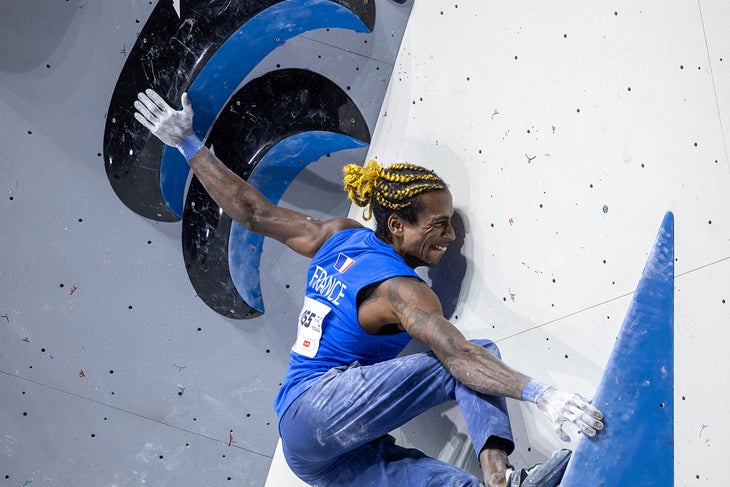
RESULTS
BOULDER
Men
- Kokoro Fujii (JPN)
- Tomoa Narasaki (JPN)
- Manuel Cornu (FRA)
- Aleksey Rubtsov (CFR)
- Nimrod Marcus (ISR)
- Anze Peharc (SLO)
Women
- Natalia Grossman (USA)
- Camilla Moroni (ITA)
- Stasa Gejo (SRB)
- Elena Krasovskaia
- Brooke Raboutou
- Andrea Kumin (SUI)
SPEED
Men
- Danyil Boldyrev (UKR)
- Erik Noya Cardona (ESP)
- Noah Bratschi (USA)
Women
- Natalia Kalucka (POL)
- Iuliia Kaplina (CFR)
- Aleksandra Miroslaw (POL)

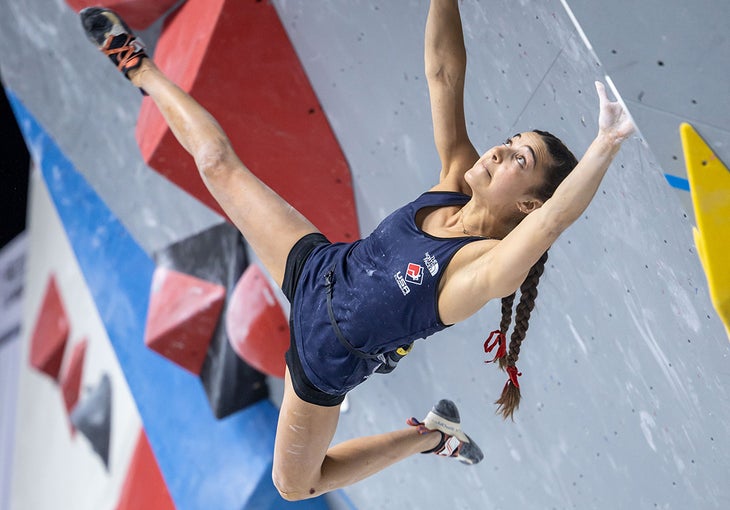
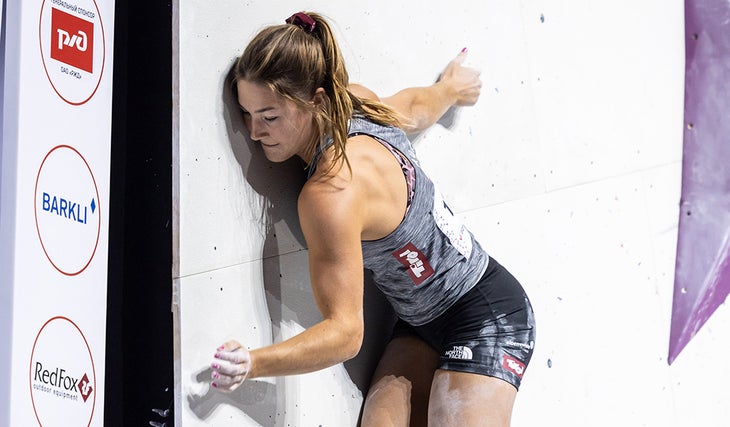
The post Fujii Wins Bouldering Championships—But the Sexualization of Female Athletes Continues appeared first on Climbing.
]]>
Where is trad climbing in World Cups? Where are the alpine and mountaineering aspects? Comp formats need to change, obviously.
The post We Need to Rethink World Cup Competitions. Seriously. appeared first on Climbing.
]]>
This article first appeared on Gym Climber.
Mountaineering, alpine and trad climbing need to become part of the World Cup competition circuit. It’s only common sense.
As it stands, World Cups only test a small slice of the climbing pie, an unfortunate situation, not to mention elitist–why should the best compete on the biggest stage? In an effort to illuminate a path forward for growing the base of competition climbing, I’m putting my ideas out there.
Change the competition format, and we level the playing field.
So, where is trad climbing in World Cups? Nowhere, is the answer. But there’s an easy fix. For bouldering and lead comps, make all athletes carry a full rack, waterbottle, phone and rain shell on their gear loops. Outlaw chalk. Use holds from the late 1990s and make all competitor’s shoes two sizes too big. Crack some plastic holds. Make it sketchy. Forget to sink all the screws in the volumes. Remember when Jernej Kruder broke that hold in Toulouse and it was the talk of the town?…that’s just a taste of the drama we could have. All competitors must be hungover and dehydrated as well, and they must carry at least two melted chocolate bars in each pocket. Lastly, in the middle of the route, have two variations to the top, one of which is the actual top while the other leads to an unprotected runout and a potential fall over a non-padded area stacked with cinderblocks and rusty nails. Bonus points for checking Mountain Project and peeing while on route.
Now, onto alpine climbing. You might think the Ice Climbing World Cups test alpine skill. Nope. The best way to simulate alpine conditions is to have the aforementioned Bouldering and Lead comps, apply those rules in full, but allow the audience to throw volumes down onto the athletes, to replicate falling rock. Sprinklers dishing out a steady stream of freezing water will be mandatory, as will climbing at night. The comp starts at 12:30 in the morning. Competitors must have eaten two gels in the past eight hours and they must be convinced that if they don’t top out, they will never see their family again. If an athlete in the Alpine World Cup needs to retreat, they have one option: they have to rappel over the cinderblock zone with a core-shot six-mil cord on a fractured volume.
Mountaineering is not represented either. But again, easy fix. Climbers will have to half-gag themselves with a rag, to mimic lack of oxygen. Seven layers of clothing will be mandatory, as will be oversized gloves so as to ensure you can’t actually climb anything. Taking place on a nearby park, the crux of the route will be figuring out what old fixed line to use, because if you use the wrong one, a pitbull is unleashed on you. To replicate intestinal issues, climbers will have to eat street food from dodgy carts for the prior month, as well as drinking water from only gas-station bathrooms.
Consider all of these ideas copyrighted.
The post We Need to Rethink World Cup Competitions. Seriously. appeared first on Climbing.
]]>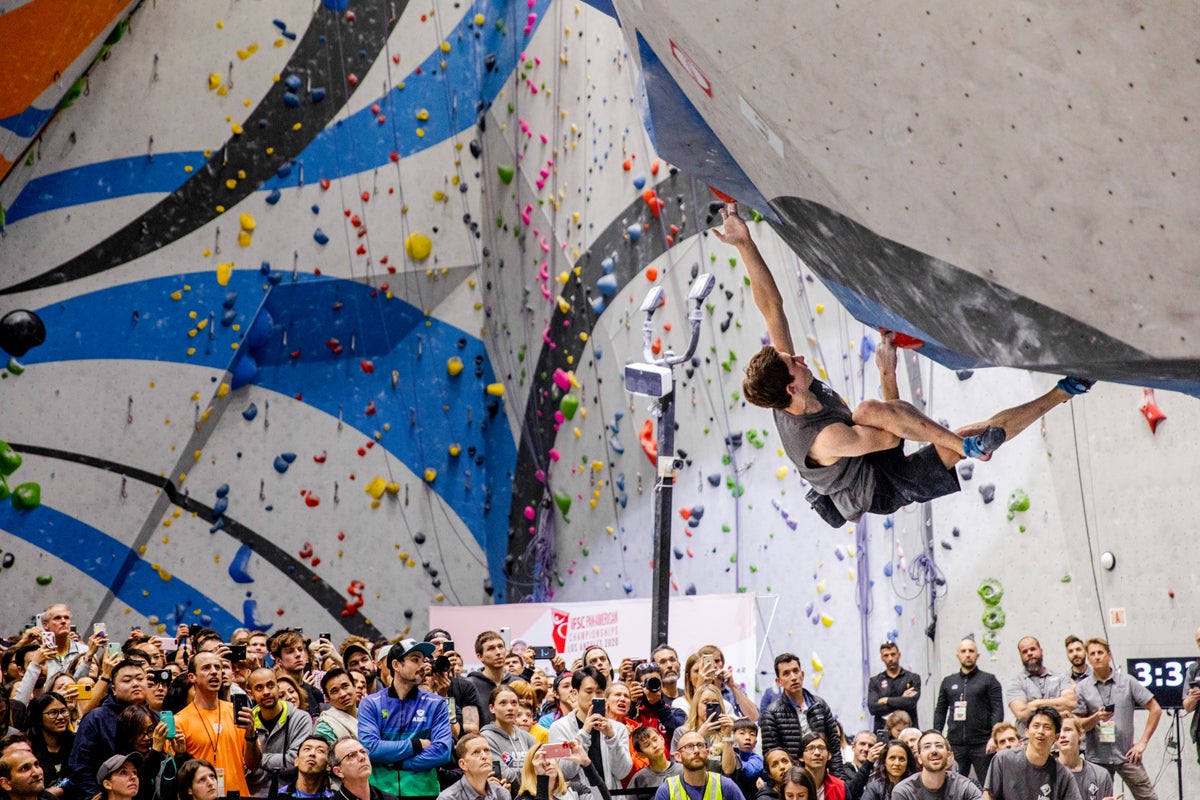
Colin Duffy securing his Olympic berth at the 2020 Pan-Am Championship in Los Angeles, pre-pandemic.Luke Webster Everyone has a moment when the coronavirus appeared on their radar. For me, this was the International Federation of Sport Climbing’s 2020 Pan-American Championship, held at Sender One in Los Angeles from February 27 through March 1. The competition … Continued
The post The Silver Lining to the Olympic Postponement appeared first on Climbing.
]]>
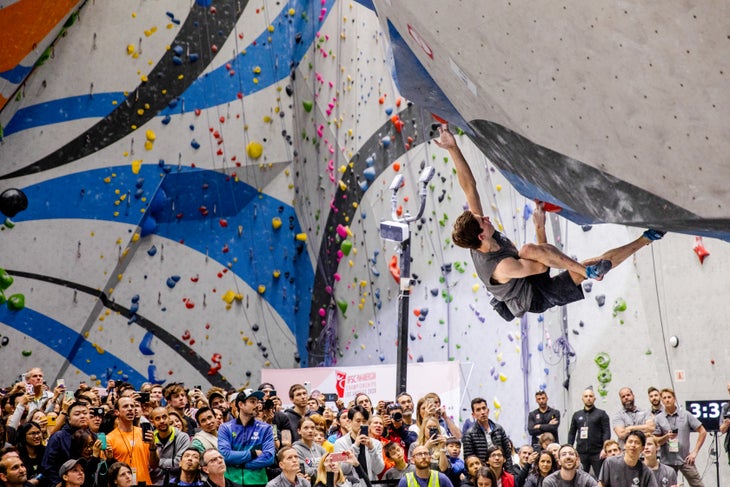
Everyone has a moment when the coronavirus appeared on their radar. For me, this was the International Federation of Sport Climbing’s 2020 Pan-American Championship, held at Sender One in Los Angeles from February 27 through March 1. The competition awarded two Olympic berths—to American Colin Duffy and Canadian Alannah Yip—and was the first (and so far, only) Olympic climbing qualification event on American soil. With highlights such as Yip’s tears of joy as she was lowered from the lead wall, a new American speed record of 8.052 seconds set by Emma Hunt, and an enthusiastic crowd, the spectacle was a booming success. But as I jotted notes for a Climbing.com recap from atop the media mezzanine, I felt like something was up.
At a press conference, a reporter asked Nathaniel Coleman if he was concerned that the virus might impact the Olympics, for which he’d qualified in Toulouse, France, in November/December 2019. Ever-astute, Coleman said that he would continue to train, and if the Olympics were to be impacted, that would be bigger than sports. A few hours later, I was talking with other members of the press and some officials, and the virus came up again. Not to worry, we all figured. The 2018 Winter Olympics in South Korea had seen a norovirus outbreak; the 2016 Summer Olympics in Brazil had been coupled with the Zika virus; the 2020 Olympics might have a few coronavirus cases—so what? Then, on the gym floor, a friend nudged me. He showed me a shocking text message about his apparel-company employer cancelling all nonessential travel due to the virus.
In the weeks that followed, the coronavirus became the dominant storyline as public life was put on hold and events—including the Olympics—were postponed or cancelled. First, the International Olympic Committee threw around the phrase “scenario planning,” then executive Dick Pound said a delay was inevitable. On March 24, the Games were formally postponed, and shortly thereafter new dates were announced—July 23–August 24, 2021. All qualifying athletes would keep their berths. (For more, visit climbing.com/compchannel.)
The Olympic climbers took to social media to support the postponement. “I’m happy to have this part of the equation settled so that we can as a human race focus on the Covid-19 epidemic … ,” Canada’s Sean McColl wrote on Instagram. Some national federations—including Canada’s—had previously stated that they would not take part should the Games happen in summer 2020. As quarantining became the new normal, the Olympians trained at home—on hangboards, on home walls, on stone tile. McColl encouraged Instagram followers to try daily challenges that included solving a Rubik’s Cube while planking. American Kyra Condie posted photos of her home wall and invited people to make up problems. The Czech Republic’s Adam Ondra, who has been vocal about his struggles with speed climbing, said the postponement allowed him one more year to “improve both mentally and physically.” Granted, nobody was training on an ideal setup, but nothing about the world was ideal.
Yet the fact that plans for the Olympics—and the rest of the world—became topsy-turvy so quickly has brought us together. At a time when Olympians are supposed to be demonstrating otherworldly skill, we find them humanized. Like all of us, they’ve been cooped up. Yet ultimately, all this strangeness will make the Olympians’ eventual glory even more compelling. Plus, we now get a whole new year of Olympic hype—bonus time during which Olympians can enjoy more exposure. And, as Brooke Raboutou told Climbing, “[The Games are] just a year later, which gives me more time to train.”
Some climber-Olympians have already used the situation to become community leaders or improve morale. Switzerland’s Petra Klingler gave away jewelry and gift cards to fans. Colin Duffy took over USA Climbing’s Instagram account to post his home workout. Japan’s Akiyo Noguchi released a series of short training videos on Instagram so that her fans could join in. These are all instances of Olympians connecting with fans in new ways amidst the crisis. And, as we finally leave our homes, we can all collectively rediscover climbing, too. That will be bigger than sports.
John Burgman is the author of High Drama: The Rise, Fall, and Rebirth of American Competition Climbing, which chronicles the history of American competition climbing.
The post The Silver Lining to the Olympic Postponement appeared first on Climbing.
]]>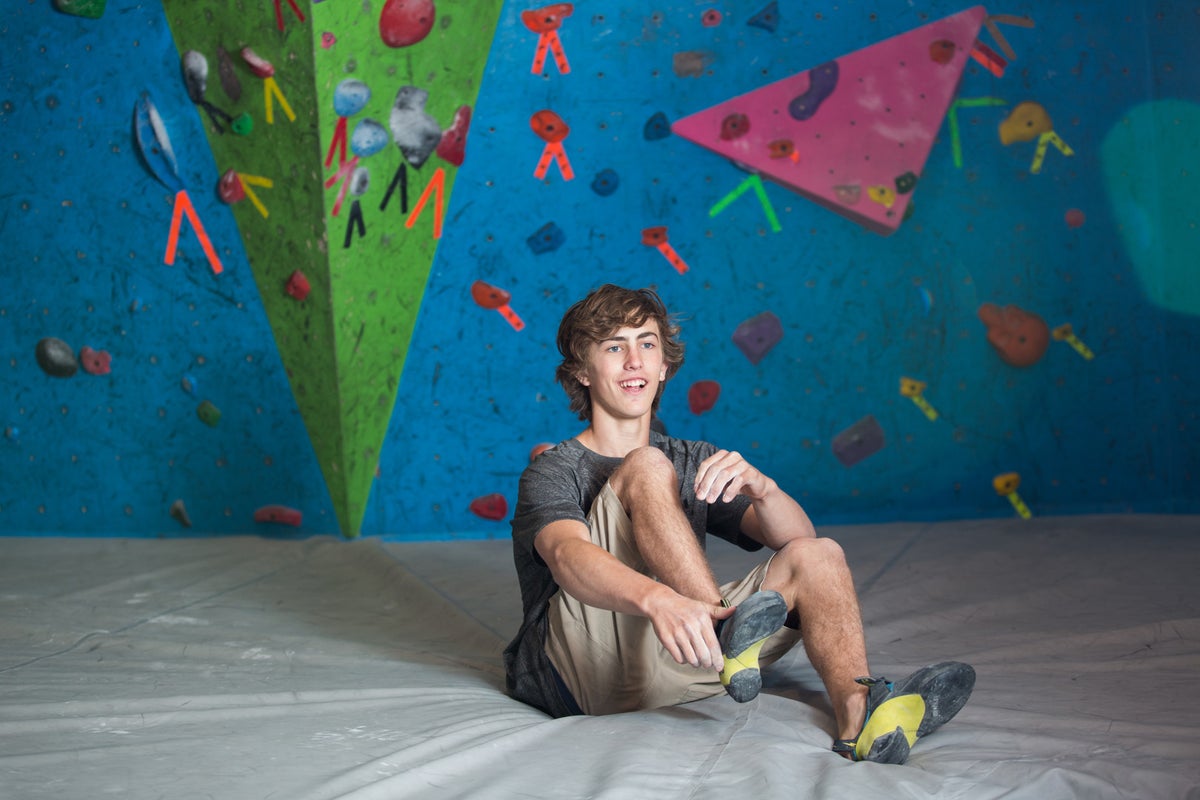
An old-school former climber tours Boulder’s youth comp scene and learns why it might be the best thing happening in the sport.
The post The Kids Are All Right appeared first on Climbing.
]]>
When I was a kid growing up in the 1970s and ‘80s, the adults in my life didn’t exactly encourage climbing. Whether I was toppling furniture as a toddler or falling out of trees in grade school, anytime my feet left terra firma was cause for concern and reproach. The only isolation room I experienced was my own bedroom—when I was grounded for tearing loose some shingles trying to mantle past the overhanging eve onto the roof of our house.
Like most climbers of my generation, I got into the sport after I left home and went off to college. There I fell in with the mountain-club crowd and soon found myself dangling from cliffs and bashing my knuckles on frozen waterfalls.
In those days climbing still retained its rebellious underpinnings. We may not have been the derelicts and outcasts who put up all the classic lines during the ‘60s and ‘70s, but, nonetheless, we engaged in risk with a wantonness of spirit that ran counter to accepted norms. To wit: my college lay nestled in the fertile hills of Vermont’s Champlain Valley. The Adirondacks perched just the other side of Lake Champlain, an hour’s drive away. To get there, we crossed a half-mile-long bridge at the southern tip of the lake, where it pinches down before emptying into the Hudson River.
One day we stopped at the bridge and did something that had always tempted us. We walked out to the midpoint, lowered a climbing rope down to the water, pulled it up about 20 feet to give ourselves a suitable margin, and fixed it to the bridge. That left a good 80-plus feet of rope dangling. We pulled it up and one of us tied into the end. He clipped some ascenders to his harness, traversed sideways about 50 feet, and jumped.
He jugged up as quickly as possible so the next guy could have a turn before the inevitable happened, which it did while this one pendulumed over the water cutting loose whoops of exaltation. A New York state trooper pulled up and ordered us off the bridge.
“But sir,” our ringleader said, pointing to a small plaque riveted to the steel a few feet away from the anchor point, “we’re on the Vermont side.”
The statey looked at the plaque. Then, quite astonishingly, he turned back to us, shrugged, got back in his cruiser, and drove off. We finished our jumps and hustled off the bridge before a Vermont trooper showed up.
Later, we marveled at how we had gotten away with breaking some law or other, yet, due to what should have been an inconsequential technicality, were all but given the New York State Police’s blessing to carry on merrily.
And so with climbing cliffs: there was the visceral rush to be had from the exposure and adrenalin, but also an equally thrilling, if less palpable, sense that we were pulling off some sort of intrigue. To a kid just out from under adult supervision, climbing with one’s friends—learning largely through trial and error how to place gear, build anchors, twist in ice screws—felt like this glorious secret, a loophole in society that would surely be closed if only it were discovered and investigated by authorities.
* * *
Climbing has come a long way since I first laced up rock shoes and tied into a rope in 1990. El Capitan has seen its first free-solo, which back then seemed about as likely as traveling to another solar system—conceivable, but in no way realistic. As with other seminal feats in recent years like the Dawn Wall, it was headline news throughout the western world, a sensation among climbers and non-climbers alike. And climbing is now an Olympic sport, debuting in the 2020 Tokyo Games. The top climbers aren’t even “climbers” anymore, they’re “athletes,” well nestled within the folds of respectability.
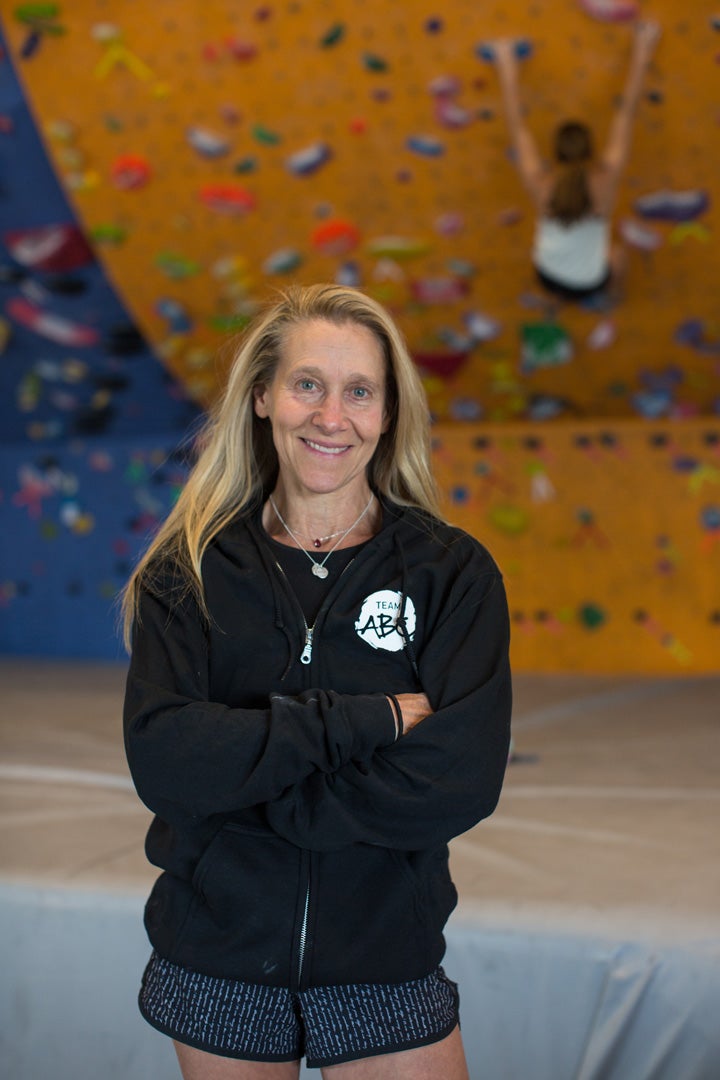
“I always refer to the Team ABC kids as ‘athletes,’” says Robyn Erbesfield-Raboutou, former world-champion competition climber and owner and head coach of ABC Kids Climbing in Boulder, Colorado, a facility dedicated to developing young climbing talent. “They are athletes—they’re coming to us three days a week, nine to twelve hours, participating in competitions. They’re serious about it. Even if they’re six years old, they’re already showing that they’re athletes.”
I’m sitting in Erbesfield-Raboutou’s office at ABC shortly before her elite-level team commences a three-hour evening practice. I’ve come here to see what this structured and sanctioned youth competitive climbing is all about. I know next to nothing about indoor comp climbing, having only first heard of a discipline called speed climbing—something that resembles an action-hero film scene more than any kind of climbing I’m familiar with—a week or so earlier. It was only when I entered the gym and saw a banner displayed prominently over the entrance touting an ABC athlete’s recent first place in the Youth World Championships that I learned that there is a Youth World Championship.
I’ve been told that if I want to see the epicenter of elite youth climbing in the U.S., this is the place. After watching a video in which Erbesfield-Raboutou says, “it’s not Funtopia, it’s really a program where we teach rock climbing—that’s who we are. Our goal is to build the best climbers in America,” I’m canted a bit toward thinking that the soul of the sport I deeply loved for almost 20 years has withered and is being replaced with the striving, must-win compulsion my generation seems to inflict on everything it touches. I wasn’t dissuaded from this view when I talked with Erbesfield-Raboutou on the phone to set up the visit. She insisted on vetting anything I write mentioning ABC as a condition of granting me access to her program. She mentioned specifically that she has certain “trade secrets” she doesn’t want printed. I know very little about Erbesfield-Raboutou other than what I may have read about her in the 1990s when she was winning World Cups and I was devouring the climbing magazines like a bag of pretzels after a long multi-pitch on a hot, sweaty day. I remember now only that she always appeared earnest and intensely driven in photographs.
I ask Erbesfield-Raboutou about the goals of her program.
“The goals of the competitive team are to build a well-rounded climber actually, despite the fact that competition is our main focus,” she says, “one who has respect for the community, the environment, and themselves.”
Her words drop in a measured and practiced meter. I probe some more, trying to get beyond what sound like prepared talking points. I ask what are the common misconceptions about her program.
She tells me one might be that the coaches push the kids beyond the point of having fun. “If they’re coming in the door, it’s because they want to be here,” she replies. “We have kids that really love what they’re doing and I think we’ve created an environment, having a kids-only facility, where they walk in the door and they’re just psyched.”
Erbesfield-Raboutou and I chat for another 20 minutes. Among other things, she tells me how she starts kids climbing as young as two-and-a-half years old and how, because she trains them methodically from such a young age, she can get a level of performance out of them that she would not recommend other coaches, without specific and extensive experience working with kids, attempt to replicate.
“We live in Boulder, Colorado, and we have the strongest kids in Boulder,” she says. “The program that we put together for our kids is appropriate for who they are as athletes.”
Erbesfield-Raboutou tells me that she has several kids in her program whose families have moved to Boulder from other parts of the country so the child could train at ABC. She has kids as young as 12 who are sponsored by outdoor companies with free gear, and at least one kid a few years older who receives a cash salary from sponsors. I ask about how the Olympics will influence what she does going forward. She replies matter-of-factly only that she expects to be training kids for the Olympics.
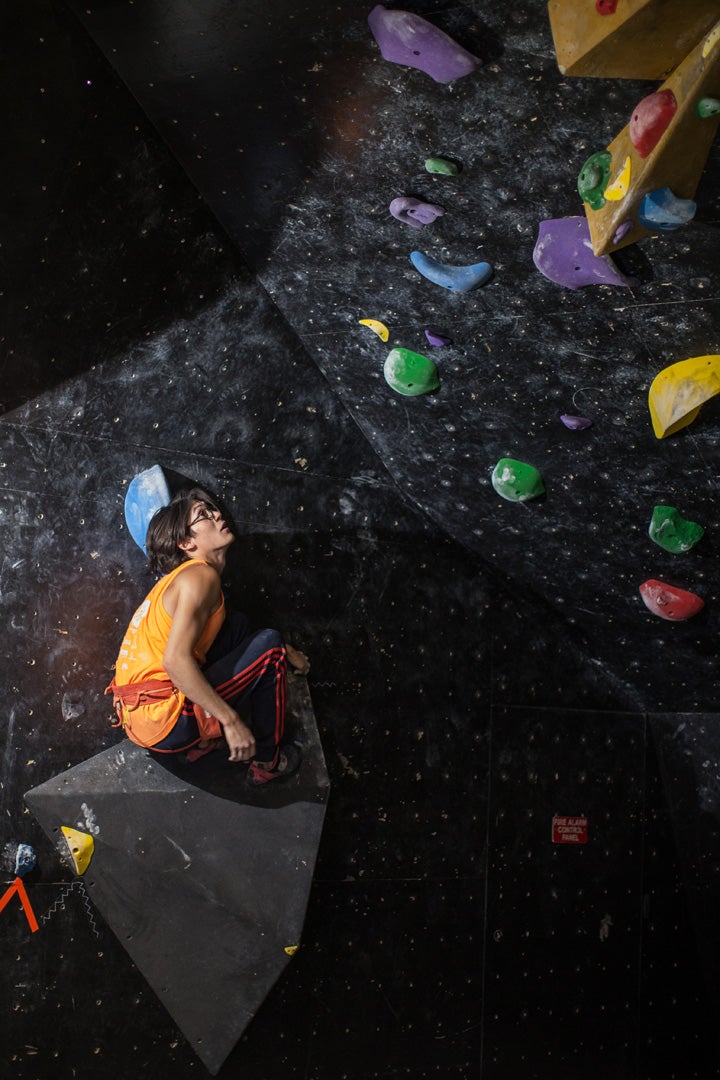
As we wrap up, she steps out into the gym and brings in Max Burgess, 18, a guy she describes as one of the most dedicated and driven in her program, even though he’s only been climbing a couple years. He’s here early, getting in some extra workout time before practice begins. Max talks in a quick, clipped cadence, telling me he recently moved to ABC from another program because he wasn’t being pushed hard enough.
“I’d go into my old gym like forever trying to train and stuff. I just wouldn’t really come back tired,” he says. “I always leave here feeling super tired. That’s why I joined this team.”
When I ask Max about his plans for the future he talks vaguely about maybe going to CU Boulder at some point. Erbesfield-Raboutou cuts in. “He’s focused on his climbing right now. I think it’s totally OK to say that,” she says. Then she turns to Max. “Be really clear and transparent with people—if that’s where you are, and you’re not in school because you’re focused on your climbing, that is so OK.” Max nods and smiles abashedly.
“Yeah, that’s awesome,” I chime in, thinking back on my fifth-year prep-school reunion. I played in the alumni vs. varsity lacrosse game and, after the game, strolled up to my old coach to say hello. He asked what I was doing and I happily told him I lived out West, climbing, skiing, and pounding nails to pay the rent. He looked at me disgustedly for a moment. Then, without saying anything, turned and walked away. I never saw or spoke to him again.
That incident left me chagrined to say the least, and my immediate reaction is to give Max the figurative pat on the back and echo Erbesfield-Raboutou’s whole-hearted support. But then I think some more about the contrast between this moment and my own youth: I didn’t have any mentor figures telling me it was “so OK” to focus my life on climbing. And while my parents weren’t overtly displeased with my chosen lifestyle, they certainly weren’t motivating me to go as far with it as I could, as Max says his parents are. To be a climber—one squeezing all the juice you could out of that lemon—you had to take a detour off the traditional path to success. Climbing defined your sense of self as existing outside of the prevailing mores, and you necessarily cultivated a certain defiance, which you shared with other climbers, toward the social pressures funneling you into a more conventional life. It made for an informal brotherhood: nothing could be more important than climbing, and you were willing to stigmatize yourself in the eyes of others, sacrifice some respectability, to live that life. We didn’t have the Olympics to train for; we were just addicted to clinging to the sides of cliffs for god-only-knew-what reasons. I wonder whether that pointlessness conferred some deeper meaning to climbing that might be lost on this new generation—something I now feel compelled to get to the bottom of.
Max gets up and heads back out into the gym. Erbesfield-Raboutou and I follow. The younger kids in the after-school recreational programs have mostly cleared out, replaced by a dozen or so lithe and sinewy teenagers. They’re milling about, chatting with one another, stretching, or casually warming up on the bouldering walls.
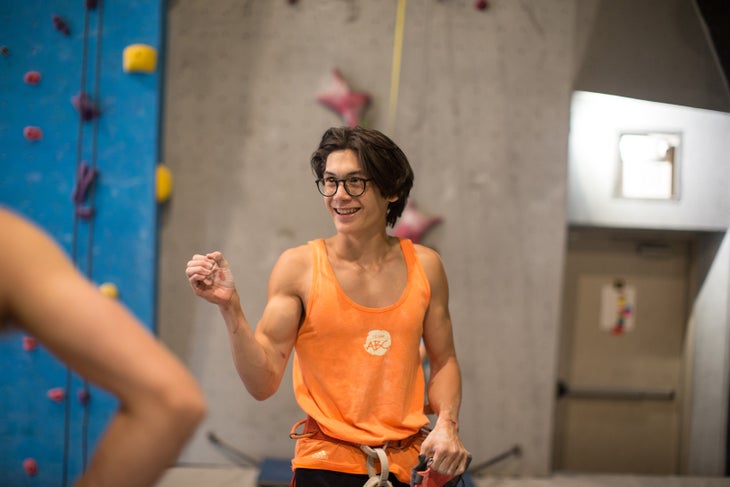
Erbesfield-Raboutou tells me a little about the history of ABC. She started it 15 years ago in a spare room at the Boulder Rock Club when her own children, Shawn and Brooke—both now world-class climbers who compete on the international stage—were just toddlers. She says there wasn’t much of a climbing community for children back then, so she decided to start her own.
“The community that has been built for them has now been built for others. I love kids and I love climbing—it makes sense,” she says.
Standing next to Erbesfield-Raboutou, who’s now 54 years old, I realize how slight she is. She appears to be barely over five feet tall, and I’d have to flip a coin to guess which side of 100 pounds she’s on. I ask about her own climbing, and she says she’s still getting after it as hard as she can. Then she ends our interview, telling me she needs to attend to practice.
I mill about on my own for a few minutes, taking in the place. ABC, which opened its current facility five years ago, is a tiny gym by today’s standards. The tallest walls stand only 15 or 20 feet high. Only a few have fixed quickdraws and anchors, which appear more for practice clipping than actual leading. I notice more banners. ABC has evidently won the team national bouldering championship several years running.
Then a guy pops up in front of me. He has shaggy, unruly hair, like he just got zapped with 110 volts, and true to his appearance, he crackles with energy. He tells me—the words zipping out rapid-fire—that Erbesfield-Raboutou sent him over to talk with me. Though he’s smiling and congenial, he’s twitching like a Labrador eyeing a tennis ball in your hand, clearly antsy to get back to his climbing.
Zach Arenberg, 16, lives in south Denver, an hour-plus drive from ABC. He gets himself up to Boulder three days a week to train, leaving immediately after school to avoid the worst of rush-hour traffic. He sits in the parking lot waiting for practice to begin, cranking out homework for a couple hours before coming inside to crank on the walls. He’s been climbing seven years, having started at a rec center in Denver. His goal is to make it back to Nationals this year, but he says so in an off-handed way as if it weren’t very important.
“I climb outside as much as possible,” he says. “Most of my goals are for outside. Competition I just do for fun mostly.” I ask what’s fun about competing. “Because you get to hang out with all the other strong people—it’s a good time.”
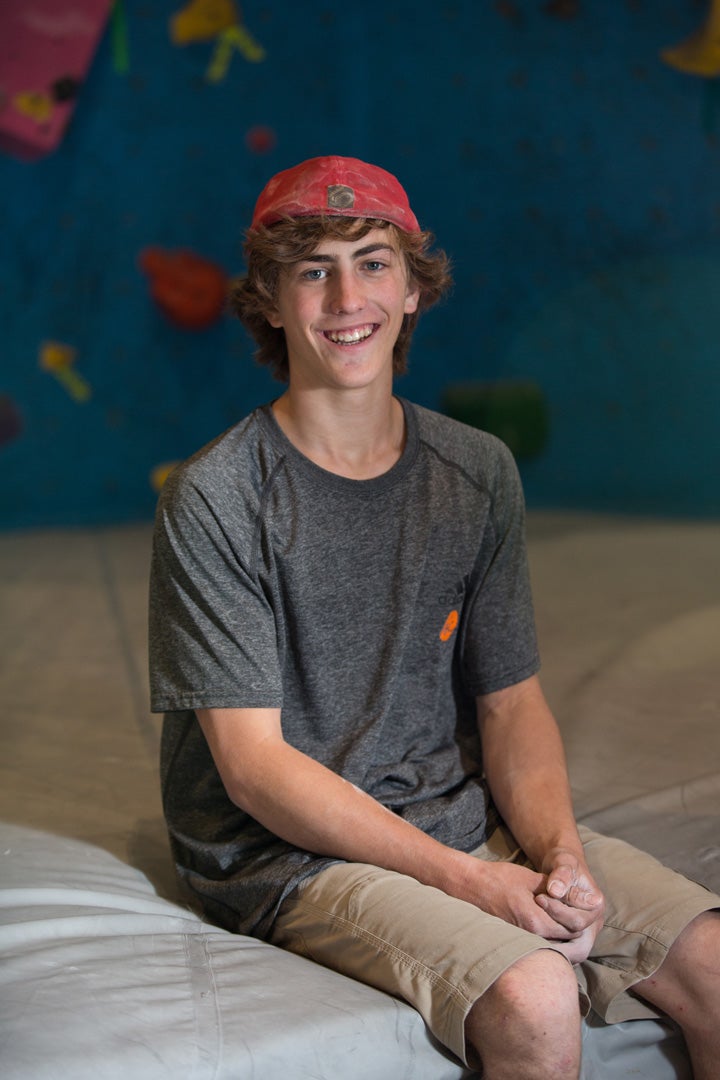
Then I ask something that’s been on my mind from the beginning, whether climbing is a team sport or solely an individual one. He pauses momentarily for the first time before answering. “When you’re climbing it’s pretty individual, but preparing for it is a team thing,” he says.
I’m eager to learn more about the team aspect of climbing, which is something I never experienced with the sport. Sure, I had bonding experiences with partners—some of the most intense in my life—and the sense of membership in a nebulous tribe of sorts, but the ritual of gathering in a group with a strong collective identity day-in, day-out, like my high-school football and lacrosse teams, never played a part in my own climbing. So I ask Zach about the atmosphere at ABC.
“It’s so fun,” he says. “Yeah, it’s so fun.”
I want to get more about this, but I’m afraid that poor Zach will blow a fuse if I don’t release him back to the climbing walls. And perhaps he’s just given me the most eloquent answer I could hope for anyway, so I give him a quick “thanks” and he darts away.
* * *
Drum and bass plays over the PA system unobtrusively, like mood music in an upscale restaurant. I’m standing on the mezzanine overlooking a group of kids lounging at the base of a new boulder problem just put up by Garrett Gregor, coach and head route setter at ABC. Practice is in full swing now, but the vibe is surprisingly relaxed.
Erbesfield-Raboutou and another coach stand on the periphery of the group, as each kid, one by one, attempts the problem. It looks desperately hard. I ask Gregor, who’s standing next to me, what it’s rated.
“As a setter I tend to shy away from giving grades to things,” he says, “but I thought somewhere in the range of at least V12 to V15.”
At first no one comes close on the problem, but, as the session continues, a couple of the older boys manage to get it, and everyone makes it well past the start holds, which I’m not sure I could even hang. I also notice very little in the way of formal coaching. I keep expecting Erbesfield-Raboutou to interrupt the session to offer critique or demonstrate some nuance of technique. But she just stands back joining in the chorus of encouragement—the same stuff climbers egg each other on with at the crag: Come on! You got it! Stick it now! and so on. I ask Gregor about the lack of direction being given to the climbers.
“From a coaching perspective, you don’t want to be telling somebody how to do something every time because somebody might find their own way,” he says. Then he explains that this is a free-flowing bouldering session wherein the kids just attempt whatever problems that want. “It’s ‘let them have at it,’” he says.
Earlier in her office, Erbesfield-Raboutou told me that climbing style has changed rather dramatically in recent years, so much so that a climber who put up a 5.14 say, 20 years ago, would have done the route noticeably differently than a climber today. Modern climbers are much more dynamic and fluid compared with those of yesteryear.
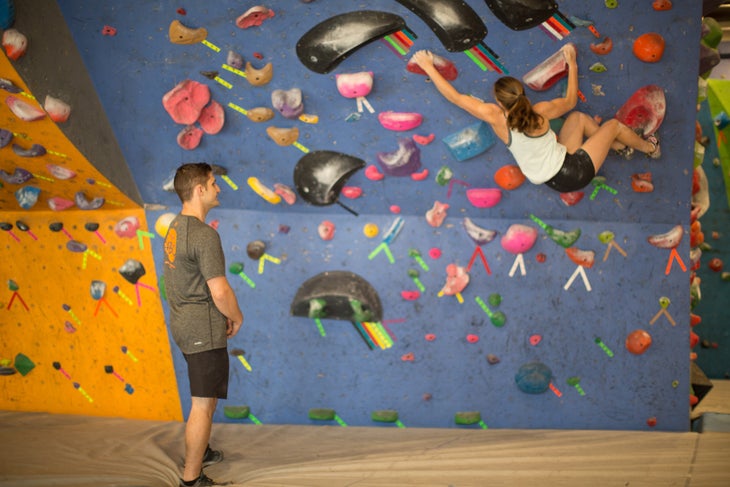
“The nature of the sport has changed a lot in that it’s super young and frolicy,” she said. “So an older climber is going to be a little more reserved and set back, whereas the younger climbers are just balls-to-the-walls. I mean, they just go.”
Which is just what I’m watching here: the kids literally throw themselves from hold to hold, using momentum to stick moves that seem implausible to my eye.
Eventually, Erbesfield-Raboutou directs everyone up to the mezzanine where the various campus boards, hangboards, and similar training panels are located. They break out into groups of three or four kids, each with a coach, and begin more structured training of the sort I’ve expected to see here. I edge toward Erbesfield-Raboutou’s group of girls. She sees me and gives me a look that halts my approach. Despite her rather insistent and business-like demeanor on the phone, she has been nothing but warm and welcoming toward me ever since I arrived at ABC earlier this evening. Now, however, I’m sensing that I might be witnessing one of her so-called trade secrets, so I stand back and observe quietly without asking any questions.
The girls run timed laps on a steeply overhanging panel roughly eight feet by eight feet and peppered with holds on a three- or four-inch grid. Erbesfield-Raboutou keeps time while each girl takes her turn. The mood is quiet and respectful, reverent almost. As time goes on, my presence feels more and more intrusive. It reminds me of a trip, more than 20 years ago, up to Baffin Island. Our team hired Inuit guides to haul us and our gear some 70 miles deep into the Fjords with their snowmobiles. They were some of the most gregarious and fun-loving people I’ve ever met, constantly joking and laughing and very much including us in their banter. One day I awoke and looked out of our tent to see them all huddled around a small fire 100 yards or so away from camp. I walked over to see what they were up to, and got close enough to realize that they were roasting meat from a freshly-killed baby seal. But as I approached, they gave me furtive and unwelcoming glances. We had established an open sharing of food and stores between our team and them, so I expected to be waved over to taste a morsel of their most prized quarry. But no; I suddenly realized I had intruded on a moment of sacramental importance. I beat a hasty retreat back to the tent.
And so now I choose this moment to take my leave, tossing a quick wave goodbye to Erbesfield-Raboutou when I briefly catch her eye.
* * *
Earlier this year, Scott Davie found himself tip-toeing across a tiny ledge on Castle Rock in Boulder Canyon. The ledge petered out and he had to make a big move, stepping across a blank gap in the rock to the next set of holds. His rope drooped across the gap and then snaked up and around a corner out of sight.
“Take in!” he yelled.
The tug at his waist pulled him off balance and he nearly fell. He looked down 150 feet of sheer vertical cliff to the ground. He’d never experienced this kind of exposure before. Like has happened to most novice climbers once or twice in similar situations, Scott Davies felt himself starting to wig out.
Scott, his wife Rhonda, and their son Quinn, age 12, sit around a table on the back patio of their north Boulder home as Scott recounts the story.
OK, I’m thinking, I remember being in Scott’s shoes once. Now suppose it was my 12-year-old kid’s anchor and belay I had to trust. I ask Scott about this and he says neither the anchor nor his son’s competence bothered him; he was just a little freaked out by the position. He managed to real in his panic with a few deep, calming breaths.
“Quinn has always led,” he says. “At this point Quinn’s a stronger climber and certainly the more experienced. He’s done all the gear placements, so it means he’s always done the anchor builds.” In fact, Scott tells me he just did his first lead—mentored by his son—only a month earlier.
Quinn Davie found climbing the way many kids do these days: When he was five or six, his parents took him to a gym. He liked it well enough to get his own shoes and harness, but for him it was just another sport or activity, like soccer or track, that he tried and didn’t much take to. Quinn didn’t think of himself as an athlete; he’s a cerebral kid with a keen, analytical mind. He gravitated more toward building stuff—rockets, cardboard boats, ramps for his bike.
When Quinn was ten, Rhonda looked out the window to see that he’d somehow strung himself up in the large front-yard tree with a rope and his climbing harness. When he came inside Quinn mentioned that he might like to try climbing some of the rocks he could see in the foothills just beyond his neighborhood. So Scott bought a book on top-roping, learned the basics of anchor building, and the two started climbing outside. It was then, when Quinn learned about gear, knots, and rope systems, that he fell in love with the sport.
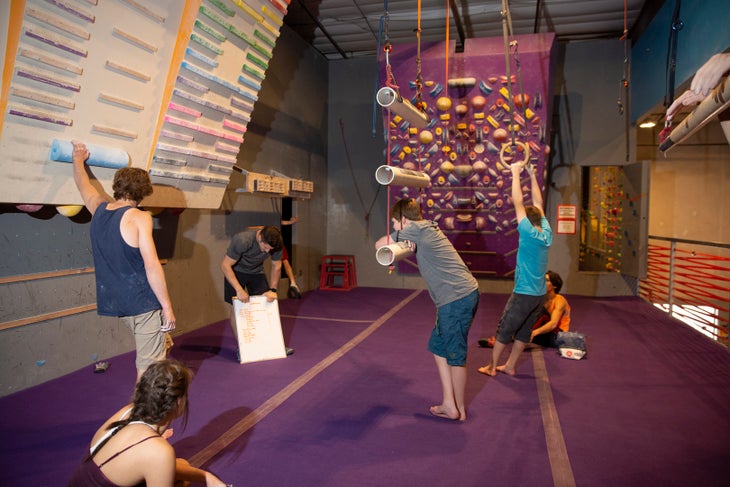
“Quinn is passionate about climbing,” says Rhonda. “Your kids, they try all kinds of stuff—this is the first thing that I have seen that’s an enormous passion.”
Soon after Quinn got bit by the climbing bug, he joined the team at the Boulder Rock Club, began training, honing his technique, and competing. Now he could climb circles around his father, so Scott and Rhonda hired guides from Colorado Mountain School to take Quinn on bigger climbs outside. They took him up into RMNP and out to the desert, and taught Quinn how to place gear and lead. Now Quinn regularly hauls his dad up routes around Boulder and Lumpy Ridge. Other climbers often do a double take when they realize this little kid is basically guiding his dad up climbs. The two recently did a route at Castle Rock and when they got down some people started asking Scott for beta about the climb.
“I just point to Quinn and he does all the answering,” says Scott.
I look over at Quinn who, with just a hint of a smile, nods in agreement. He wears eyeglasses, is soft-spoken and still carries some baby fat on his small 12-year-old frame. He doesn’t come off as particularly athletic, that is until I glance down at his hands. Thick sausage-like fingers lay preternaturally curled in his lap, sporting a few cuts and gobies. I imagine these hands dusted with a little chalk, some tape around a digit or two—you’d mistake them for the dense and powerful pincers of a much older and more hardened climber.
I ask Quinn whether he enjoys competing on the team.
“I really like outdoor climbing a lot more, especially trad climbing,” he says. Then he quickly adds that he also enjoys the indoor competitive experience, that he’s become a much better climber as a result, and always learns a lot from participating in competitions. But he’d much rather tell me about his recent trip to Indian Creek or the mini-epic he and his dad had up on Lumpy Ridge last year.
What about his goals and aspirations? I ask. I’m expecting the rock-climbing equivalent of the Little Leaguer’s dream to play in the World Series—El Cap speed records, Patagonian linkups. Quinn tells me he hopes to climb the Casual Route on the Diamond this summer with one of his guides, but other than that he has no grand aspirations for future climbs. He actually asks me what routes I’d recommend. I tell him The Bastille Crack in Eldo is a good one if he hasn’t done it yet. And of course he’ll have to do the Naked Edge eventually. I look down at his little paws. “One of the cruxes is a number-three-Camalot-size fist jam, so you might want to wait a few years—but someday …”
* * *
I’m standing with Quinn’s coach, Chris Wall, long-time director of Team BRC, at the Boulder Rock Club’s local youth climbing competition. I’m here to see the kids of Team BRC and Team ABC—many of whom I’ve now had the chance to meet and talk with—in action.
This isn’t the high-pressure, do-or-die format like the Regionals, Divisionals, and Nationals later in the season. In local comps, the kids have three hours to tick as many routes—which are ranked according to their difficulty—as they can. They mill about the gym, trying this route or that, giving belays to their friends, lounging on the pads between burns. The atmosphere feels fun and relaxed, but it’s a comp nonetheless; they’re here to make a good showing for themselves in preparation for the bigger contests to come. I ask Wall how he helps his climbers cope with the pressure.
“It’s not so much trying to control feelings as trying to control actions when you’re having those feelings,” he says. He goes on to explain that this mental aspect of climbing and competing is a big part of the team curriculum and key to the program’s overall goals of developing important life skills and having a lasting impact on kids’ lives. “Can you control your actions when you are awash with emotion? That seems transferable to just about everything for the rest of their lives—relationships, work, you name it,” he says.
I mention an observation I’ve made which is that the kids seem to manage themselves quite well when they fail on a route; I’ve seen no angry outbursts or even head-hanging looks of disappointment. I recall to him how, back in our heyday, loudly cursing at the injustice of a thwarted send was de rigueur behavior at the crags.
“Temper tantrums seem a lot less prevalent than back when I was climbing consistently,” he says. “In the ‘90s I threw some really good warblers myself—I was the occasional shoe thrower, yelling at the top of my lungs. And then once I really understood just how lame that is [laughs], I kind of revised my behavior.”
Wall says he absolutely expects kids to keep from coming unglued. “If you throw a tantrum at a competition, we’re going to talk about it for sure,” he says. “It’s unacceptable for any of the kids on the team—that type of expression. It brings everybody down.”
It occurs to me that when young people rebel against convention and authority, they often throw the baby out with the bathwater. In Wall’s and my day, we climbers prided ourselves on operating according to a different set of values outside of the mainstream. We sometimes forgot that the virtues we were taught in Little League or the Boy Scouts don’t really fall out of fashion; you’re never too cool to keep your cool. Wall heads off to attend to his kids, and I go in the other direction to check in on one of the ABC girls. Natalia Grossman, 16, moved to Boulder from Santa Cruz, California a few years ago so she could train with Erbesfield-Raboutou and crew. I find her tying in at the base of climb #25. There are 27 routes in all, ranging in difficulty from 5.9 to 5.13 and numbered from easiest to hardest. The majority of the routes are skewed toward the harder end of the spectrum, so #25 is a stout proposition.

I hop up to the mezzanine for a better view. Natalia climbs with a fluid power, moving fast and maintaining momentum through the blobby holds. The climb seems to consist only of slopers and crimps, in roughly equal measure—a pump fest to be sure. About halfway up the route, I notice her becoming just a bit erratic, but she keeps moving, keeps sticking each dyno. As she closes in on the anchors, I can tell she’s flaming out fast, but she maintains an implacable composure, clipping the last draw from a grubby little crimp, then launching herself upward for the final hold before the finish jug. She hits the hold but can’t quite stick it and drops 15 feet onto the rope. She spins slowly through the air toward the mezzanine, smiling with a look that says, Wow, that was hard!
I catch up with her a few minutes later resting on the sprawling pads beneath the bouldering wall.
“Good effort, you almost had it,” I say. Then I comment on her composure and ask about performing under pressure.
“You got to remember it’s just for fun,” she says through her big smile. “As long as you’re having fun then you’ll be more relaxed. If you take it too seriously then you’re going to be really stressed on the wall and you’re not going to climb well.”
Sure, but what about at the bigger comps with the do-or-die format? I ask.
“I have to tell myself over and over again [that it’s just for fun]. You just have to convince yourself that what you’re saying is true because you get really stressed out in the bigger competitions,” she says. “You just have to accept failure, and once you can accept that then you can really try your hardest.”
I ask if her parents are here at the comp and she cheerfully offers to go look for them with me. We find Norma Grossman up on the mezzanine. While Natalia heads back down to the gym floor, I ask Norma about the family’s move from Santa Cruz to Boulder. In California, she and her husband were driving long distances so Natalia could climb and train. There isn’t a strong program in Santa Cruz, to they trekked up to Berkeley—an hour and 45 minutes one way—at least once a week so she could work out with a team there. Natalia had met kids from ABC at comps, and one day she said, “Why don’t we just move so I can be at ABC?”
Turns out, the idea wasn’t so far-fetched; Norma’s husband could take his job with him, and she’s a teacher with 15 years of experience, so quite marketable. It was hard taking the plunge of selling their house, but once the move was made and Norma had a good job, it was a big relief. Now they live five minutes from the gym.
“It was a lot of work, but it was worth it. We’re very happy,” she says.
I ask how Natalia got into climbing. Do they climb? No, not at all it turns out. The family just happened to live close to the one gym in Santa Cruz. “We went for a walk in our neighborhood and just by accident happened to see it. Natalia wanted to go see what’s inside,” Norma says. “We walked in and Natalia was just like, with her mouth wide open, wanting to do what they were doing… She was four years old at the time.”
Little Natalia walked right up to the counter and inquired about climbing. The staff told her she couldn’t climb until she was six years old. “So once she was six, she came and asked us to enroll her at the gym, which we did right away—on her birthday,” Norma says. “That’s how she started.”
I’ve heard the same thing again and again from these kids: many of them started climbing on their own initiative. The inspiration, the sustained interest and motivation, these are entirely self-generated in a lot of the young climbers I’ve talked with. Mostly, like Norma and her husband, the parents don’t climb and knew nothing about the sport until their kids got involved in it. And another curious thing: a lot of the kids, like Quinn Davie, never considered themselves athletic until they climbed.
Surf Thompson, 18, of Team BRC, started climbing indoors two-and-a-half years ago. He’s climbing 5.13- now in the gym and goes outside as much as possible. Before Surf discovered climbing, he only dabbled in sports.
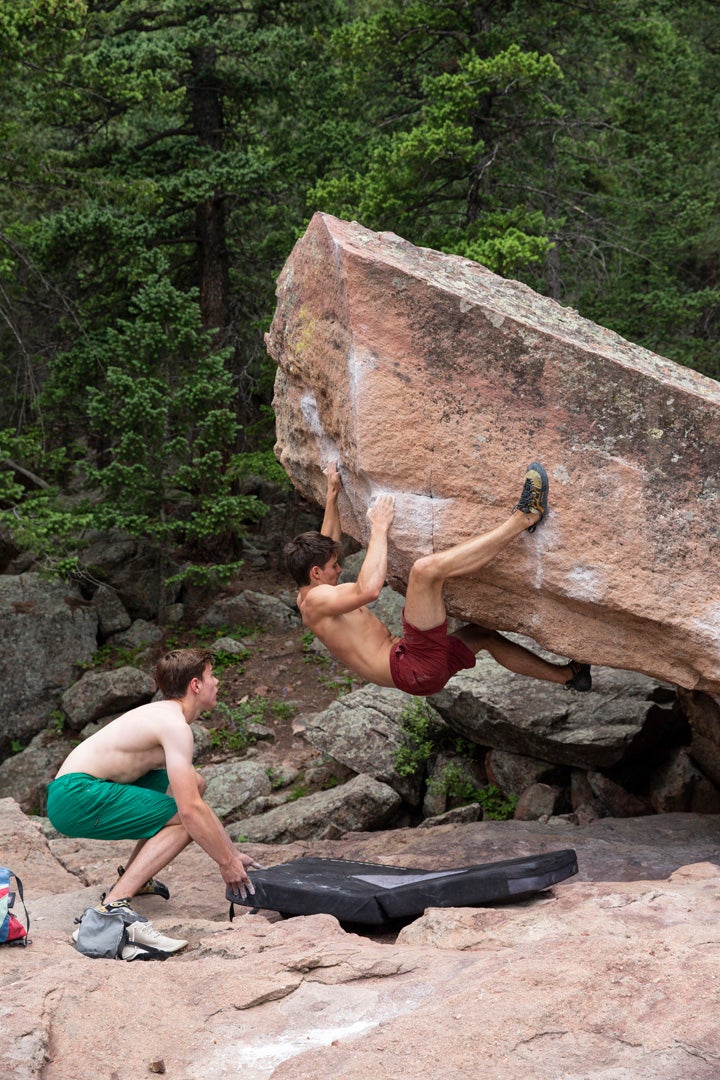
“I tried baseball, I did a little bit of soccer, I tried karate, I ran cross country, I tried a lot of sports and I just couldn’t really get into any of them,” he told me at a practice prior to the comp. “And then I started climbing and I really enjoyed it. I don’t know why—I think probably because there’s no rules and you’re not competing directly against other people.”
When I pointed out that he climbs on a competitive team, Surf explained that he doesn’t see competitions as “head-to-head,” but rather as competing against the route and against himself. He said he likes competing because it helps make him a mentally stronger climber. “It forces you to really focus,” he said. He also told me the team has taught him how to deal with failure and use it as motivation rather than getting discouraged. “It’s given me a lot of confidence,” he said.
As Norma and I wrap up, Natalia comes back to tell us she just got #25. I’ll later learn that she pulled out the win for the girls age 16-17 category with that send. But there’s no talk of first place now, she’s just happy to have finished the route.
* * *
In 1987, Michael Kennedy, long-time editor of Climbing, encapsulated the general view (not necessarily his own) of American climbers at the time, noting, “many feel that organized competition discourages the pursuit of adventure and fosters an increased urbanization of the climbing experience.” Back then, climbing as scored athletic competition was in its infancy, having just begun in Europe two years earlier. The early comps were held on real cliffs with manufactured routes—chipped and glued-on holds—so that an on-sight format could be used. Climbers on this side of the pond were collectively scratching their heads. The cultural milieu of American climbing existed on a wholly separate plane from that of corporate-sponsored televised events with their podiums, prize money, and formal rankings. Many chaffed at the direction their sport was taking in Europe; controversial climbing trends that began over there—rap-bolting was the latest culprit—invariably made their way stateside.
Lynn Hill competed in many of these early events. Writing in the same issue, she expressed her own qualms about formalized competition: “Climbing in this contrived set of circumstances, in front of 10,000 expectant eyes, bears little resemblance to the usual act pursued strictly for its personal value.” She also presciently predicted that, were competition climbing to gain any traction, it would need to take place on artificial climbing walls of the sort most climbers were still unfamiliar with.
Today, the vast majority of climbers in the U.S. go inside a building to pursue the sport, and most everyone embraces its new identity as an Olympic-worthy endeavor. Indeed the proliferation of gyms and, more to the point, the gym experience—how cranking plastic has come to augment the regimens of even the most gnarled-knuckled hunchbacks—has “urbanized” the sport to an extent Michael Kennedy circa-1987 never could have imagined.
And yet—
“It’s not an outdoor gym, it’s the wilderness,” says Naomi Guy of Boulder, regarding the environmental toll taken by the ranks of gym rats who sooner or later take to the outdoors. Guy, 50, is a former two-time British national champion who competed on the World Cup circuit in the 1990s. But her passion was always for the heady and picturesque gritstone trad climbs that she cut her teeth on in her early years. I’ve called Guy to get her take on the youth-climbing scene in Boulder.
She tells me she moved to Colorado in the late ‘90s after falling in love with the Western landscape during a competition stint in the U.S. “I’d never experienced anything like it,” she says of her first day in Vedauvoo, Wyoming. “I thought cowboys and Indians were going to come galloping round the corner on horseback—it’s an amazing environment.”
Guy still climbs regularly around Boulder. Ten or fifteen years ago she started seeing heavy impact from climbers at her favorite bouldering areas. “I did start seeing places just getting trashed—overpopulated, crashpads being thrown on small saplings, loads of litter, chalk tick marks everywhere,” she says. “The younger generation—and it’s not millennials, it’s teenagers—they need to be made aware of the effect they’re having on the environment.”
Long-time Boulderite and hard woman, Bobbi Bensman, agrees: “I went to an area in the Flatirons the other day, and I walked up and there were like forty tick marks on this rock. It was just like, ‘really guys?’” she tells me over the phone.
Bensman is also concerned that kids coming out of gyms don’t have the knowledge and awareness to climb safely. She regularly finds herself walking up to young climbers and pointing out their mistakes or lapses, like belay devices going the wrong way or belayers standing too far back from the wall.
“I’ve seen a lot of really scary things, like kids getting dropped almost to the ground,” she says.
Erbesfield-Raboutou is equally concerned about kids’ safety on the rock, and it’s a huge emphasis of her program, she says. Gym-to-crag is a big component of the ABC curriculum—they regularly take trips in the U.S. and abroad—and all of her outdoor programs are run by an AMGA guide with the highest level of certification. Likewise, Team BRC partners with Colorado Mountain School to operate its gym-to-crag programs.

Ushering kids into outdoor climbing as safely as possible with certified mountain guides is certainly reason enough that climbing teams do a service to the overall community. But it’s on the environmental stewardship side of things that climbers everywhere may more generally experience the positive influence these programs can have.
I catch up with Ty Tyler, National Stewardship Director for the Access Fund, on the road in his van, which he and his wife live out of full-time as they travel the country meeting and talking with land managers. Tyler tells me that a recent study based on sales of climbing equipment estimated 7.2 million current climbers in the U.S., up from 350,000 in 1991—a 20-fold increase in less than 30 years. The data doesn’t differentiate between indoor-only and outdoor climbers, but Tyler estimates that outdoor numbers have tripled at a minimum from the 350,000 figure in 1991 (when all climbers were outdoor climbers).
And anyone who’s been at the sport for more than ten years has experienced firsthand the increasing numbers vying for a limited supply of routes. Garret Gregor, the route setter at ABC, told me of a recent spring-break trip he took to the Red River Gorge.
“It was almost to the point where we had to wait in line,” he said. “At some of the areas there was probably thirty or forty people at one crag. It will be a real problem. As more people go outside, the more we’re going to have to figure out how we allow people to access it.”
One way that might happen already exists at the RRG: Tyler explains how Roadside Crag was closed several years ago due to heavy use and the resulting erosion around the base of the cliff. It re-opened recently, but only under a permit system that limits the number of climbers at any given time. And, as most climbers know, Hueco Tanks State Park in Texas has long restricted the number of people who can access the world-class bouldering the place is famous for.
If climbing gains momentum as an Olympic sport, we could see a surge of interest on top of the current growth. Perhaps most of these new climbers will never touch chalked hand to real stone, but if even a fraction of them do, there may come a point when other land managers around the country have no choice but to adopt similar permit systems at heavily-used crags.
Imagine having to get a tee time just to go clip some bolts on the local choss pile. It sounds dystopian, but it’s not too unrealistic a possibility when you consider the exploding popularity of the sport.
“My biggest concern is numbers … just feet on the ground,” says Tyler. “But I’m also really excited that our sport is gaining a lot more respect.”
Compared with when? I ask. Turns out he’s referring to my ilk’s time: “Back in the day,” he says, “the Valley Uprising sort of time frame when all the rangers were against the climbers because they thought they were just outlaws and a lot of our user group was off the radar, behind the scenes, sneaking in, climbing where they shouldn’t be, and there was a lot of push to close climbing areas, prevent bolting, those sorts of things.” (Hmm, sounds faintly familiar.) “I think we’re well on our way to being looked upon as a user group that has the ability to steward our own resources,” he says.
Tyler thinks the brave-new-world scenario of widespread top-down regulation can be avoided as long as climbers continue to demonstrate the ability to carefully self-regulate—which is where he and others at the Access Fund, Leave No Trace, and smaller local groups collaborate with youth climbing programs to produce an educated, respectful cadre of young climbers who will go outside and become the standard bearers for the next generation.
“I feel it’s less likely that the kids coming out of teams are going to be as large a contributor to the problem as just the general population of people that are coming into the gym and then going outside without having the team education,” Chris Wall tells me over the phone. “They’re not necessarily being taught the stewardship; they’re just learning this new sport.”
At the BRC comp, Wall also told me that youth competition climbing is growing just as fast as the rest of the sport. These days, comps fill up fast and organizers often have to turn away a lot of kids. Climbing teams simply can’t keep up with demand, but, to the extent they do—and will in the future—they can capture and educate a growing slice of the next generation taking to the cliffs.
* * *
People of my generation and older often look back on their youth as a golden age, regardless of time, place, or context. The knee-jerk impulse to condemn any development or evolution since one’s own glory days (back then we had leather helmets and no face masks—that was real football!) is indulged, at least in part, to assuage the pangs of slipping down the backside of the proverbial hill. It’s an easy attitude into which one can uncritically fall.
And so I came into this piece more or less agreeing with the sentiments Kennedy wrote of in his 1987 editorial. Climbing gave me the ultimate sense of freedom—no rules, no scores, no one telling what to do or how to do it. It came along in my life just after I’d been released from the confines of boarding school, where a lot of sanctimonious morality had been shoved down my throat, so I suppose the lawless spirit climbing still embodied at the time resonated particularly strongly and made a lasting impression. The fact that very few people understood the attraction of risking life and limb in the vertical world gave my generation of climbers the space and anonymity to more or less do whatever we pleased there. Sure, we respected raptor closures and the prevailing ethics of the time, but no ranger was going to tell us where, when, or how we could bivy or take a shit. For better or worse, those were my golden years.
So, although I wouldn’t have outright condemned organized competition climbing, it did always seem a rather silly pursuit to take seriously and get excited about. Climbing was about going offline, as it were, and having an experience you could only get on the side of a cliff, out away from society, not about beating the next guy, where you stood in the rankings, or even necessarily succeeding in any definite, measurable way.
I can pinpoint the moment that perception shifted: when Zach Arenberg stood before me, eyes all a twinkle, talking as if someone had pushed a fast-forward button in his brain, just basically oozing stoke out his every pore. This kid loves this place—whatever it’s about, I thought.
Now to be sure, we can certainly botch it if we’re not careful. Rhonda Davie, Quinn’s mother, wrote to me after we talked: “Regarding a competitive environment: I believe that it is alive and well amongst the parents of these young climbers…. I have witnessed parents focused more on winning than the fun…. Climbing is going to be part of the Olympics and some parents have goals for their kids to be a part of that.”
I have no doubt that Rhonda has a good read on the youth comp scene—human folly has a way of seeping into every nook and cranny of society—but I, for one, saw no Friday Night Tykes-type antics at ABC or BRC, nor at the comp I attended. And, no, these programs aren’t just churning out soulless, eastern-bloc-like climbing robots.
But they are producing ridiculously strong climbers. The leap from 5.14 to 5.15 was made by young talent—Sharma, Ondra, Hayes, et al—that came up through gyms and competitive programs. Erbesfield-Raboutou told me she thinks the modern “young and frolicy” style born of the gym sensibility is the main reason this crew is now knocking on the door of 5.16. Even Honnold got his start in the gym, and his story—feeling awkward and lonely until he came into his own as a climber—points to a heartening trend I found: through these programs, kids are discovering themselves, finding something that resonates deeply with their souls, at a young age—while they still have plenty of time to enjoy their youth. Erbesfield-Raboutou’s kids might be athletes, but, for the most part, they aren’t the Bo Jackson types who crush whatever sport they try. Climbing may be going mainstream, but it remains a niche sport in the sense that it clicks particularly well with a certain type of kid who evidently struggles to latch on to any other sport.
You won’t see Surf Thompson in any Olympics—so he says—but he and so many like him may be the real success stories coming out of youth comp programs.
“Some days I’ll think, ‘how good can I get,’ and then other days I just want to have fun with it,” he told me. “So it kind of changes, and I don’t know where it will go, but it’s opened up a ton and I’ve had a ton of great experiences with it, so I’m definitely not going to stop any time soon.”
Erbesfield-Raboutou and I talked briefly the other day. She left me with a sentiment I don’t doubt the sincerity of: “My whole goal is to bring climbing to the community of younger people. Over and above everything I did as a professional athlete, that’s really why I’m on this earth, to just share my passion with the younger generation.”
More articles by Jeff Chapman:
- In Depth: The Evolution of the Nose Speed Record
- Want to Get Better at Trad Climbing? Go Aid Climbing
- Interview: Adrian Ballinger on His Lightning-Fast Ascents of Cho Oyu and Everest
The post The Kids Are All Right appeared first on Climbing.
]]>
Left to right: Jerome Meyer (IFSC head of Olympic coordination), Heiko Wilhelm (CEO Austria Climbing), Silvia Verdolini (IFSC sport director), Francis Sanzaro (Rock and Ice editor-in-chief), Adam OndraCourtesy Black Diamond During the week of the 2018 IFSC Climbing World Championships in Innsbruck, Austria, Black Diamond hosted a panel discussion about the state of climbing leading … Continued
The post Panel Discussion: Climbing on the Road to Tokyo appeared first on Climbing.
]]>

During the week of the 2018 IFSC Climbing World Championships in Innsbruck, Austria, Black Diamond hosted a panel discussion about the state of climbing leading up to the 2020 Tokyo Olympics. Adam Ondra, members of the IFSC, Black Diamond climbing category director Kolin Powick, and others weighed in on a range of topics including Olympic expectations, the competition’s format, and more. Click the link below for a pdf of the full transcript of the hour-long conversation.
Transcript: Climbing on the Road to Tokyo (PDF)
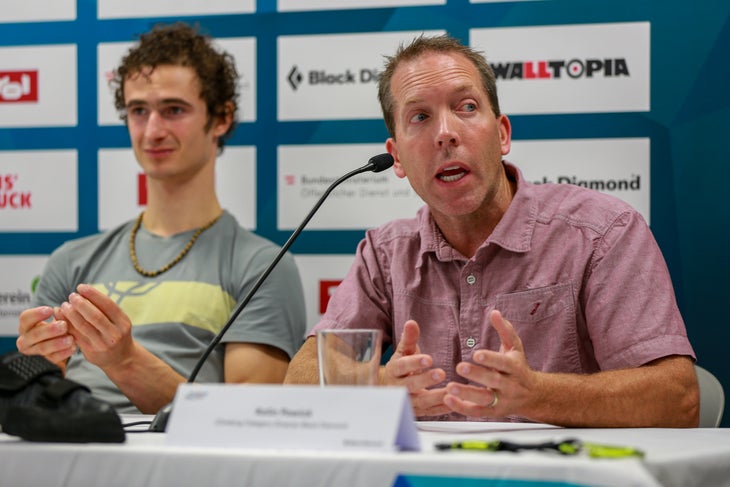
The post Panel Discussion: Climbing on the Road to Tokyo appeared first on Climbing.
]]>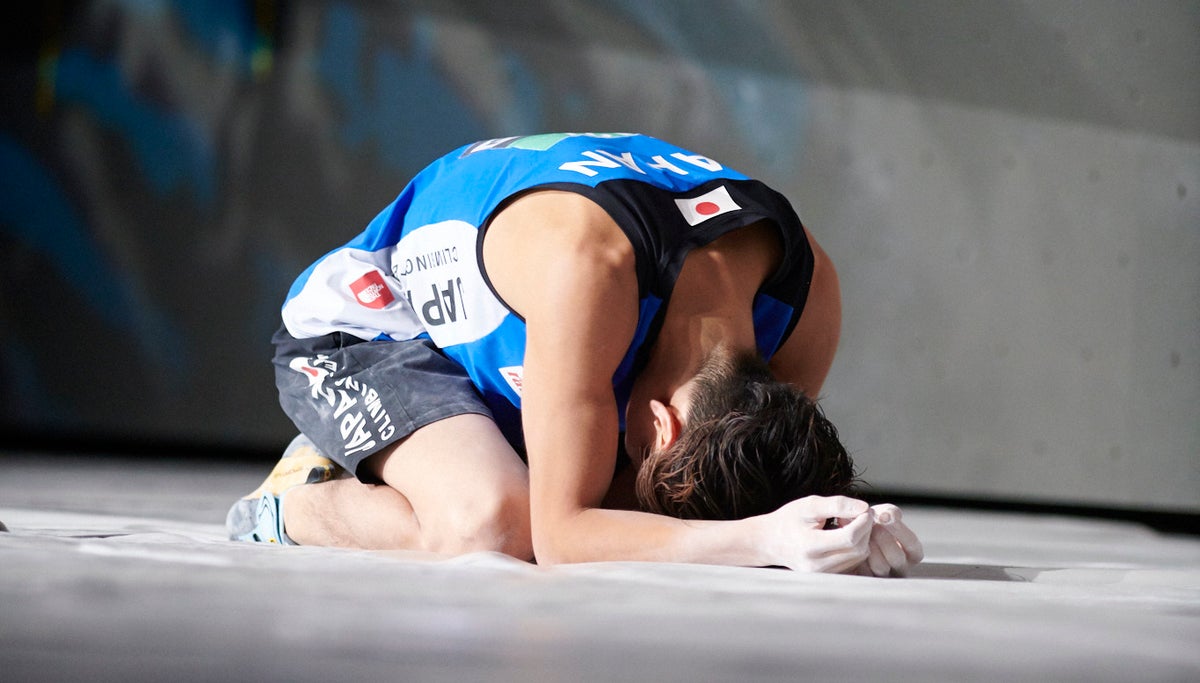
Kai Harada has an emotional moment on the mat after winning the championship, while the crowd explodes in a standing ovation.© IFSC/Sytse van Slooten 1. Kai Harada2. Jongwon Chon3. Gregor Vezonik4. Keita Watabe5. Kokoro Fujii6. Nathan Phillips U.S. Competitors 27. Nathaniel Coleman31. Rudolph “Drew” Ruana51. Sean Bailey70. Carlo Traversi116. John Brosler116. Benjamin Hanna Check back … Continued
The post IFSC 2018 Men's Bouldering World Championship Results appeared first on Climbing.
]]>
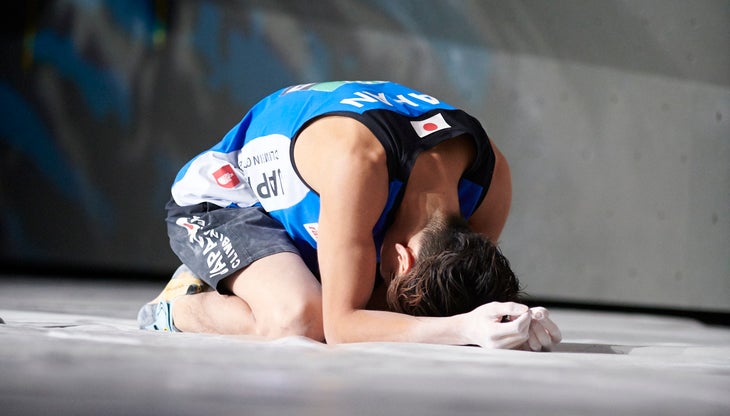
1. Kai Harada
2. Jongwon Chon
3. Gregor Vezonik
4. Keita Watabe
5. Kokoro Fujii
6. Nathan Phillips
U.S. Competitors
27. Nathaniel Coleman
31. Rudolph “Drew” Ruana
51. Sean Bailey
70. Carlo Traversi
116. John Brosler
116. Benjamin Hanna
Check back later for a more in depth report of the 2018 IFSC Climbing World Championships, and check out our Instagram story for updates throughout the weekend. Watch livestreams of all the events at The Olympic Channel.
The post IFSC 2018 Men's Bouldering World Championship Results appeared first on Climbing.
]]>
Janja Garnbret celebrates one of several semi-finals tops on her way to winning the 2018 Bouldering World Championships.© IFSC/Eddie Fowke 1. Janja Garnbret2. Akiyo Noguchi3. Stasa Gejo4. Jessica Pilz5. Miho Nonaka6. Petra Klingler U.S. Competitors 10. Margo Hayes16. Alex Puccio25. Krya Condie27. Ashima Shiraishi31. Claire Buhrfiend (tie)31. Brooke Raboutou (tie)51. Maya Madere85. Meagan Martin91. Lisa … Continued
The post IFSC 2018 Women's Bouldering World Championship Results appeared first on Climbing.
]]>
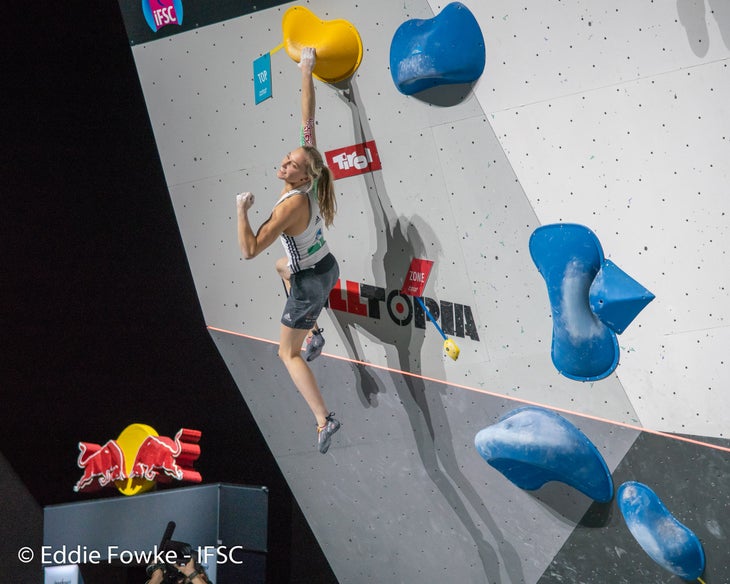
1. Janja Garnbret
2. Akiyo Noguchi
3. Stasa Gejo
4. Jessica Pilz
5. Miho Nonaka
6. Petra Klingler
U.S. Competitors
10. Margo Hayes
16. Alex Puccio
25. Krya Condie
27. Ashima Shiraishi
31. Claire Buhrfiend (tie)
31. Brooke Raboutou (tie)
51. Maya Madere
85. Meagan Martin
91. Lisa Chulich
Check back later for a more in depth report of the 2018 IFSC Climbing World Championships, and check out our Instagram story for updates throughout the weekend. Watch livestreams of all the events at The Olympic Channel.
The post IFSC 2018 Women's Bouldering World Championship Results appeared first on Climbing.
]]>
From Psicobloc Open Series: Canadian Free Climbing Championship Inc. announced the first Canadian edition of Psicobloc Open Series in partnership with The North Face, Boréale, and Kingdom Climbing. It is an international deep water solo climbing competition. This outdoor event will take place at the Aquatic Centre of parc Jean Drapeau, Montreal from August 23-25, 2018. … Continued
The post Psicobloc Masters Series Coming to Montreal August 23-25 appeared first on Climbing.
]]>
From Psicobloc Open Series:
Canadian Free Climbing Championship Inc. announced the first Canadian edition of Psicobloc Open Series in partnership with The North Face, Boréale, and Kingdom Climbing. It is an international deep water solo climbing competition. This outdoor event will take place at the Aquatic Centre of parc Jean Drapeau, Montreal from August 23-25, 2018.
The Open Series is for advanced climbers and professional athletes, the competition is internationally recognized with climbers from North America, South America, and Europe. It is a dual between two climbers trying to race each other to the top of the 55-ft. high overhanging wall. The climbers do not have a harness or a rope, meaning any mistake leads to a spectacular fall into the pool. Extended over three days, Thursday: qualifications, Friday: quarterfinals and Saturday: semifinals and finals. The competition includes four categories: Men, Women, Junior Girls, and Junior Boys who will share a $20,000 cash prize.
The interactive event will bring more than 3,000 spectators and 200 competitors from all ages. In a Californian “beach & surf” atmosphere, Psicobloc Open Series offers a variety of activities, including a second 12 ft. climbing wall above the water, free yoga classes, a slackline above water, a family section, more than 30,000 square feet of aquatic center where spectators can swim, eat on site, have a drink with friends, and more. Thanks to the generosity of our more than 60 partners, there will be more than $40,000 in prizes to giveaway to competitors and spectators alike.
“Psicobloc is an extreme and spectacular form of climbing that will undoubtedly blow everyone’s mind; for years, we’ve talked about how this format will be the way of taking climbing to the mainstream.” —Chris Sharma
For more information visit:
- Website: psicobloccanada.com
- Instagram: @psicoblocopenseries
- Facebook: Psicobloc Open Series
More Psicobloc coverage:
- Livestream: Psicobloc Masters Series 2018
- Recap and Photo Gallery: The Psicobloc Masters Series 2018
- Interview: 2018 Psicobloc Winners Jimmy Webb and Hannah Tolson
The post Psicobloc Masters Series Coming to Montreal August 23-25 appeared first on Climbing.
]]>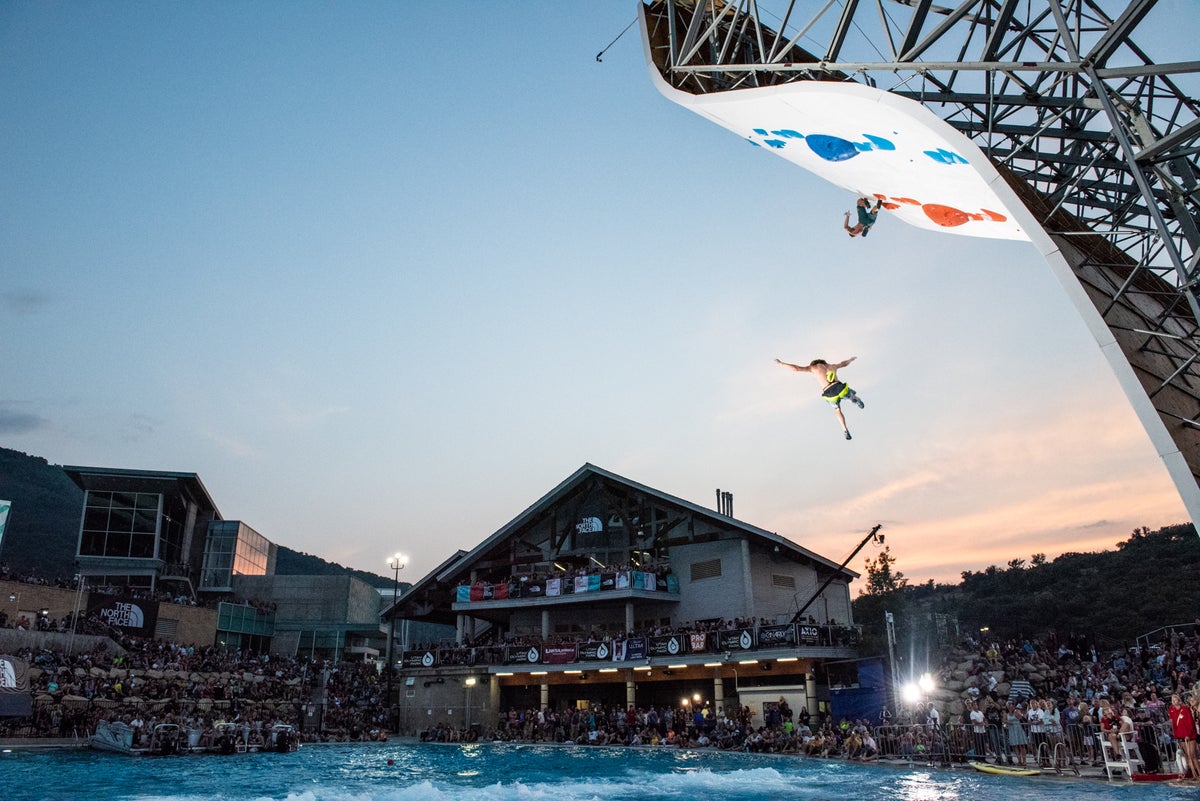
The 2018 Psicobloc Masters Series was a study in contrasts. While the invited climbers dominated the men’s field, two women advanced through the open Qualifiers to the Finals. The large crowd cheered local youth climber Sami Singleton through to a spot on the women’s podium, and strong group of international climbers added some mystery to … Continued
The post Recap and Photo Gallery: The Psicobloc Masters Series 2018 appeared first on Climbing.
]]>
The 2018 Psicobloc Masters Series was a study in contrasts. While the invited climbers dominated the men’s field, two women advanced through the open Qualifiers to the Finals. The large crowd cheered local youth climber Sami Singleton through to a spot on the women’s podium, and strong group of international climbers added some mystery to the otherwise familiar men’s field.
Psicobloc, or deep water soloing (DWS), involves climbing unroped over deep water. The Psicobloc Masters Series is an outdoor competition held on a 55-foot artificial climbing wall cantilevered out over a 17-foot deep swimming pool at the Utah Olympic Park. Two identical routes are set on the wall, and competitors climb simultaneously.
14 Photos from the 2018 Psicobloc Masters Series
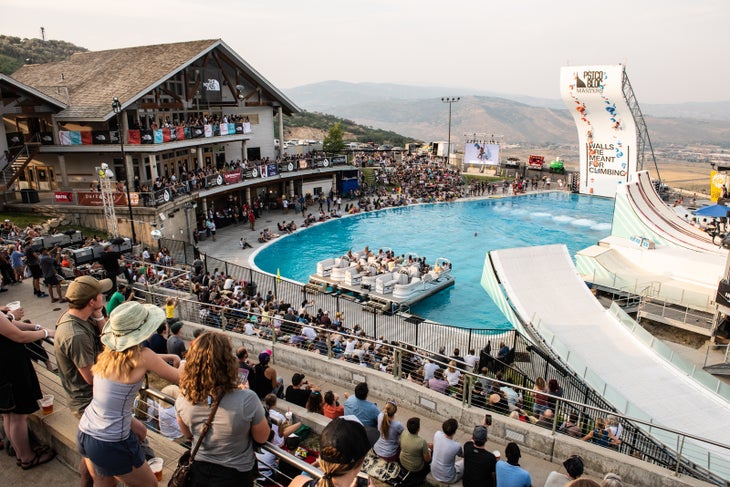
People packed the observation decks at the Spence Eccles Olympic Freestyle Pool at Utah Olympic Park in Park City, Utah for the 2018 Psicobloc Masters Series Finals. Here, Emily Harrington and Melise Edwards kick off the competition on Saturday night.

Hannah Tolson establishes a lead over Delaney Miller as they reach the overhung portion of the route. The Psicobloc Masters comp pits climbers in head-to-head matches, with the first climber to the top winning the duel.

Matty Hong settles into the starting holds and waits for the crowd to count down.
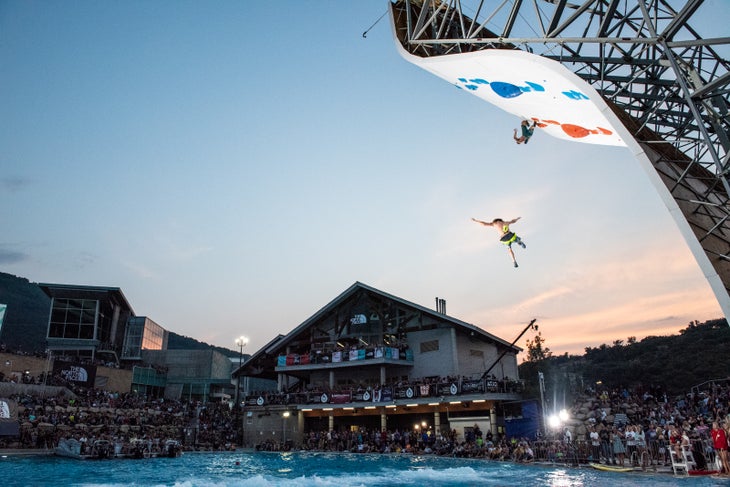
Whether you top out or fall off, there’s only one way down: a leap into the pool. Nasty falls aren’t common but they do occur. Olympic Park staff aerate the pool to break up the surface tension and lessen the impact of a fall, and lifeguards stand at the ready to rescue stunned climbers.
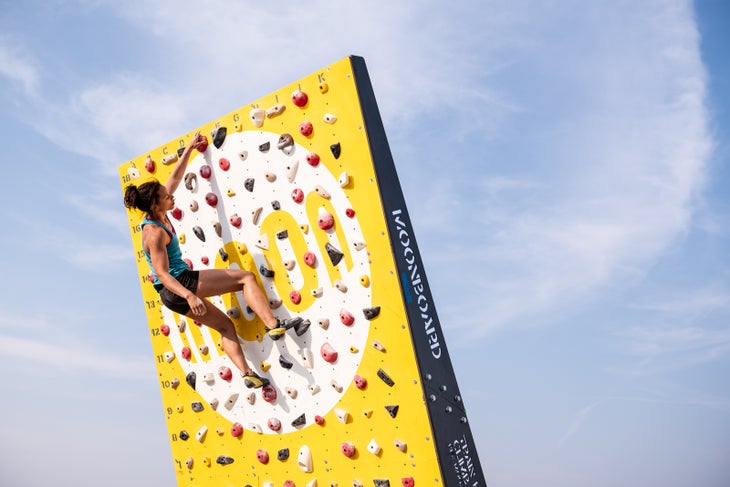
Melise Edwards warms up on the Moonboard prior to a finals race.

Sami Singleton narrowly defeats Nina Williams in the second round of Saturday’s Finals.
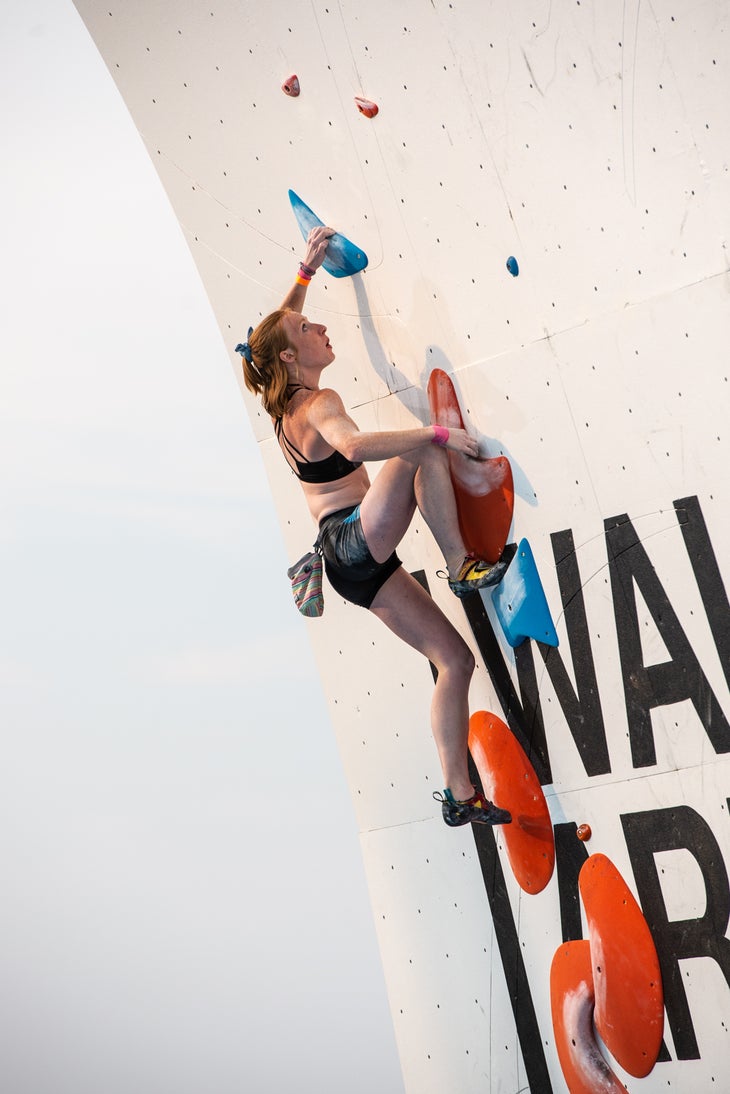
Delaney Miller, climbing with her trademark poise, races her way into the final match.
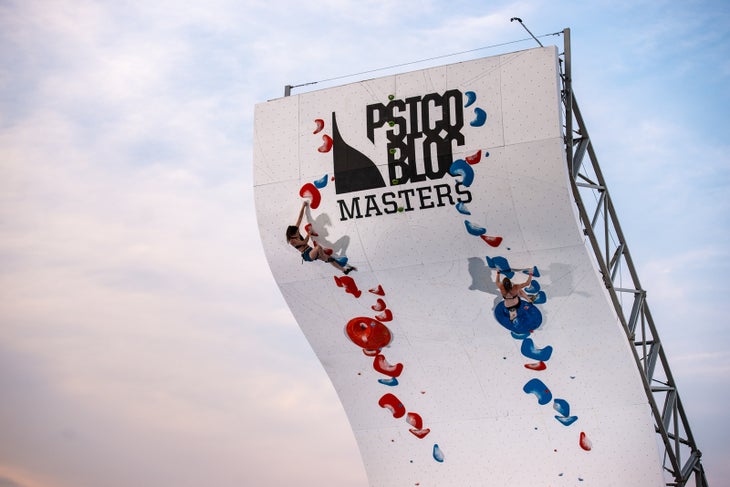
Hannah Tolson charges towards a victory for the 2018 Psicobloc Masters Series. Perennial contender Delaney Miller topped out for the third time in the finals round, earning a second place finish.
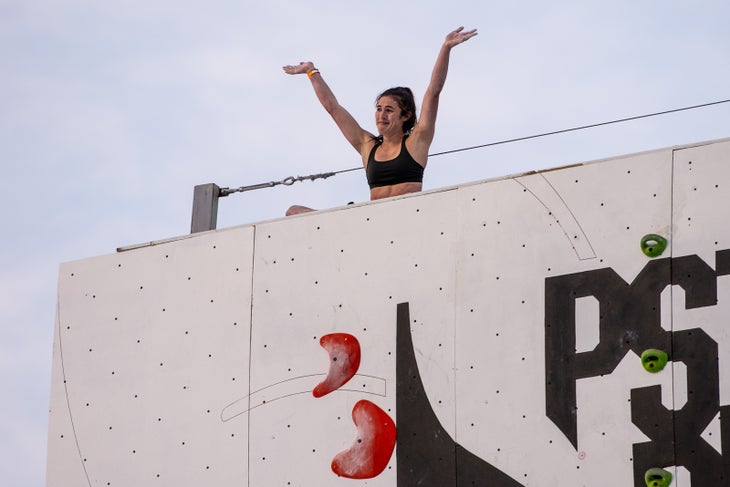
A flabbergasted Hannah Tolson celebrates her win. Toslon is the 2018 USAC Collegiate Sport National Champion.
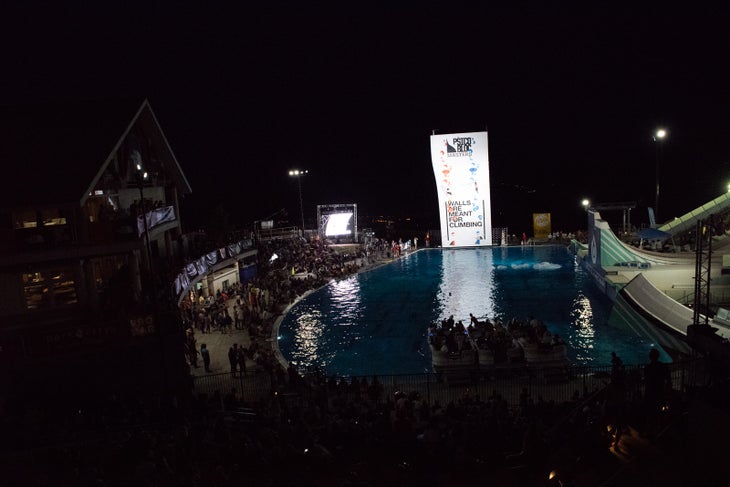
Taking place well after sunset, the scene was dramatic for the final match of the Men’s division.

Carlo Traversi checks the progress of Lucas Gaona in their quarterfinal match. The men were well matched, with several races coming down to the wire.
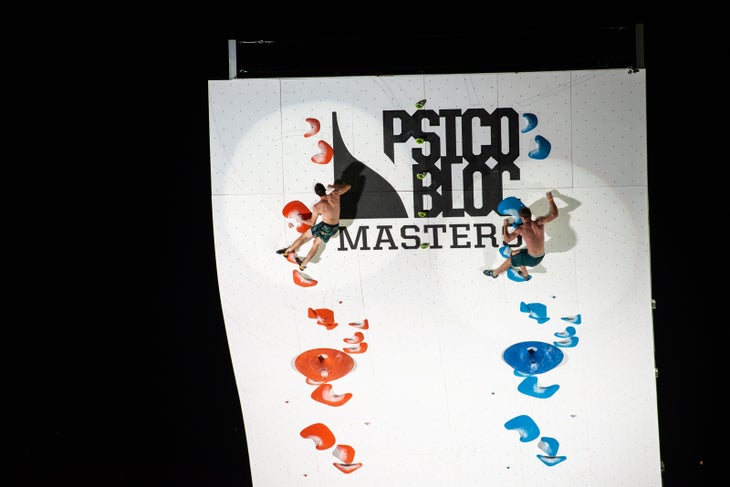
Matty Hong and Arjan de Kock neck and neck in their semifinal match. De Kock was in the lead for much of the race, until Hong overtook him as they both approached the top.

Jimmy Webb a couple moves ahead of Matty Hong in the final match of the 2018 Psicobloc Masters comp.
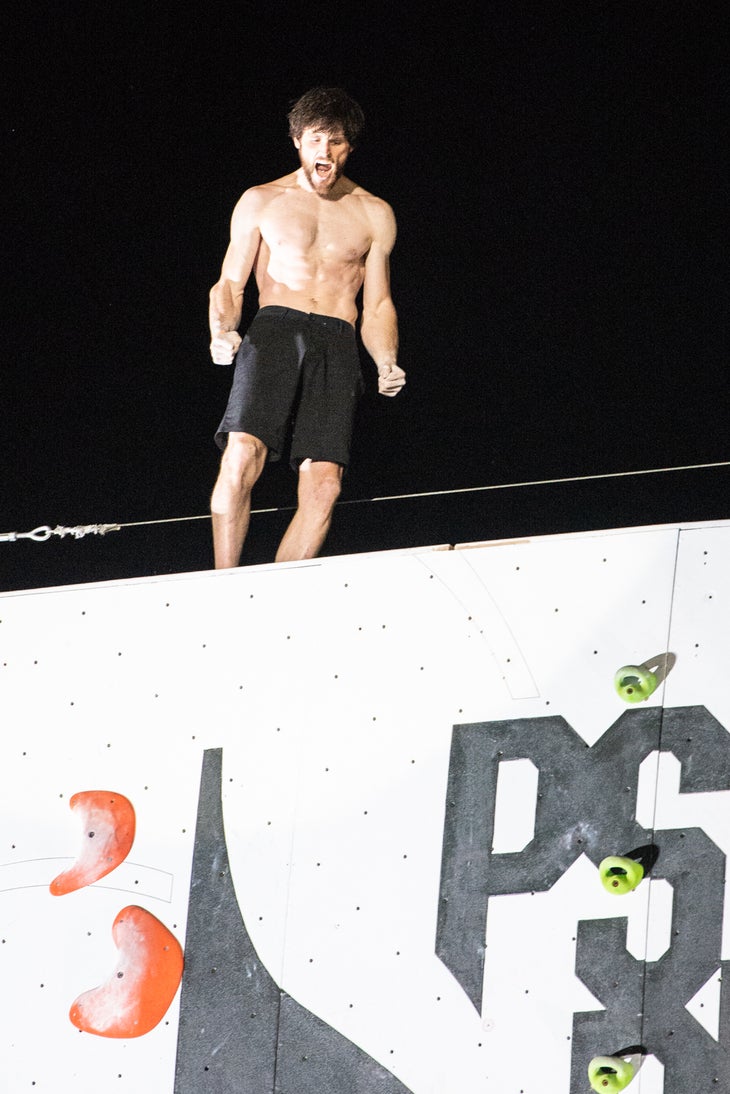
Jimmy Webb celebrates his victory atop the wall.
A cross between a tennis tournament and track meet, Psicobloc pits competitors in head-to-head races up the route. The first climber to top out wins the match. If neither tops out, the winner is determined by their high point. Perhaps the most exciting part of the competition applies whether climbers top out or not: everyone jumps—or falls—into the pool below. There is no other way down.
There were three rounds at the 2018 Psicobloc competition. On Friday, an open round provided an opportunity for eight climbers, four men and four women, to join the invited competitors. In Saturday’s seeding round, climbers made multiple ascents of the wall to determine pairings for Finals.
On the women’s side, half of the semi-finals field started in the open Qualifiers. Upstart Sami Singleton, a 16-year-old climber from Salt Lake City, narrowly defeated Nina Williams in their second-round match. Hannah Tolson, reigning USAC Collegiate ropes champion, out-dueled Sami Singleton in their semi-finals match.
The other semi-finals match paired two invited climbers, perennial contender Delaney Miller and Zoe Steinberg. Climbing with her trademark poise, Miller topped the route after Steinberg slipped off the large round volume near the three-quarter point of the route.
In the final women’s match, Tolson took an early lead and then maintained her advantage. Both Miller and Tolson looked confident and strong on their final climbs, but Tolson had more fuel left in her tank. Tolson, looking flabbergasted but joyful, sat atop the wall waving to the crowd as Miller topped out the wall.
The men’s field included several familiar faces, including previous winner Jimmy Webb and previous semifinalists Carlo Traversi and Matty Hong. Less known to the American audience, South Americans Facundo Langbehn, Felipe Carmago, and Lucas Gaona plus South African Arjan de Kock brought some international intrigue to the field. Advancing through the open Qualifiers, Joey Catama advanced to the quarter-final match of Men’s Finals.
The men’s semi-finals matches featured several Psicobloc Masters veterans. Carlo Traversi jumped out to an early lead over Jimmy Webb, but Webb overtook Traversi mid-climb and held on for a decisive win. Matty Hong staged a late comeback to earn his spot in the men’s final match. South African Arjan de Kock lead out of the blocks and through the middle of the wall, with Hong accelerating to a late lead near the top of the wall.
Hong and Webb are well known for pushing the boundaries of climbing, Hong as a sport climber and Webb as a boulderer, and both are regular contenders at Psicobloc. The two were neck-and-neck through the opening third of the wall, before Webb pulled ahead on the dyno. Webb seemed to gain strength from round to round as he chased the $5,000 purse, and finished the comp as the now five-time champion.
Results
Men’s Podium
- Jimmy Webb
- Matty Hong
- Carlo Traversi
Women’s Podium
- Hannah Tolson
- Delaney Miller
- Sami Singleton
The post Recap and Photo Gallery: The Psicobloc Masters Series 2018 appeared first on Climbing.
]]>
The American Alpine Club (AAC), America’s oldest and largest non-profit organization for climbers, is pleased to announce that UIAA World Cup Ice Climbing is coming to Denver, Colorado February 23–24, 2019. The new North American tour stop will serve as the 2018/2019 World Cup Ice Climbing Finals in which over 200 athletes from 26 countries … Continued
The post American Alpine Club to Host 2019 UIAA World Cup Ice Climbing Competition in Denver, CO appeared first on Climbing.
]]>
The American Alpine Club (AAC), America’s oldest and largest non-profit organization for climbers, is pleased to announce that UIAA World Cup Ice Climbing is coming to Denver, Colorado February 23–24, 2019. The new North American tour stop will serve as the 2018/2019 World Cup Ice Climbing Finals in which over 200 athletes from 26 countries around the world will compete for the overall World Cup in both Lead and Speed categories.
The 2019 event is the first time the Ice Climbing World Tour has come to Denver, Colorado. The weekend event will be held in Denver’s Civic Center Park and will be free to the public. The ice climbing competition will take place over two days with qualifying rounds on Sat, Feb 23, and semi-finals and overall finals on Sun, Feb 24.
“We are proud to support our U.S. ice climbing athletes and bring this impressive event to downtown Denver,” said American Alpine Club CEO, Phil Powers. “Competitive ice climbing is one of the most exciting things I’ve ever watched; the stamina, skill, and seeming impossibility of it all makes for an outstanding spectator experience. They’re up there doing crazy moves, wielding sharp tools and they hang on forever.”
Competition ice climbing combines formidable over-hanging walls of ice with artful technique and sheer power. In the lead discipline, ice climbers require great technique, tactical mastery and nerves of steel to ascend seemingly improbable icy pillars dozens of feet above the ground. The speed discipline is most closely akin to all out vertical sprint using ice axes and crampons. In 2014, competitive ice climbed debuted as an exhibition sport at the Sochi Winter Olympics. The sport is currently being considered for full-scale Olympic inclusion in the 2022 Beijing Winter Games.
Luis Benitez, Director of the Colorado Office of Outdoor Recreation Industry and event partner, also commented, “Ice climbing has a strong presence in the culture of outdoor recreation in Colorado. From our world class ice park in Ouray, to our iconic routes in Vail and Rocky Mountain National Park, this is a sport whose time has come. We are thrilled to welcome the World Cup event to Denver in February to highlight just how special ice climbing is and share that feeling with the rest of the country watching!”
The 2019 Denver World Cup Ice Climbing Competition is being hosted by the Golden, CO based American Alpine Club in partnership with the UIAA (International Climbing and Mountaineering Federation and tour organizer), the Civic Center Conservancy, Denver Sports Commission, Visit Denver, Colorado Office of Outdoor Recreation Industry, and the Denver Office of Special Events.
“We’re thrilled to help host this exciting international event in Denver’s historic Civic Center Park and expose this amazing sport to a larger population than ever in North America,” said Scott Robson, Executive Director of the non-profit Civic Center Conservancy, “Civic Center Park is the heart of Denver and has hosted iconic events for over a century. Hosting the 2019 World Cup Ice Climbing finale in such an urban setting will not only make this competition accessible to multitudes of new fans, but will also be visually stunning to watch.”
US athletes who wish to compete at the 2019 Denver World Cup will be able to earn entry at qualifying competitions.
For additional information, including how to become a sponsor, please contact: Vickie Hormuth at vhormuth@americanalpineclub.org or visit: americanalpineclub.org/uiaa-federation/
Denver Ice Climbing World Cup Schedule:
Friday, Feb 22
- Athlete Registration
Saturday, Feb 23
- Lead Qualifiers
- Speed Qualifiers
Sunday, Feb 24
- Lead Semi-Finals
- Lead Finals
- Speed Finals
- Closing Ceremony
- After Party (hosted by the American Alpine Club)
About American Alpine Club
The American Alpine Club is a 501(c)(3) charitable organization whose vision is a united community of competent climbers and healthy climbing landscapes. Together with our members, the AAC advocates for American climbers domestically and around the world; provides grants and volunteer opportunities to protect and conserve the places we climb; hosts local and national climbing festivals and events; publishes two of the world’s most sought-after climbing annuals, the American Alpine Journal and Accidents in North American Climbing; cares for the world’s leading climbing library and country’s leading mountaineering museum; manages the Hueco Rock Ranch, New River Gorge Campground, Samuel F. Pryor Shawangunk Gateway Campground, and Grand Teton Climbers’ Ranch as part of a larger lodging network for climbers; and gives $100,000+ annually toward climbing, conservation, and research grants that fund adventurers who travel the world. Learn about additional programs and become a member at americanalpineclub.org
The post American Alpine Club to Host 2019 UIAA World Cup Ice Climbing Competition in Denver, CO appeared first on Climbing.
]]>